 By Staff By Staff
October 5th, 2015
BURLINGTON, ON
The views of political personalities on issues that are critical to the social well being of the country are important and deserve the widest possible audience. Former Newfoundland Premier Danny Williams speaks out on Prime Minister Stephen Harper’s position on the wearing of the niqab during citizenship swearing in ceremonies.
The Gazette believes this country is bigger than the Prime Minister that currently leads us
Former Newfoundland and Labrador premier Danny Williams saaid in a CBC News story that some of the tactics of Conservative Leader Stephen Harper are borderline racist.
Williams, who led a Progressive Conservative government in Canada’s most easterly province from 2003 to 2010, launched his latest scathing attack against Harper and the Conservative Party of Canada on Sunday during an interview with CBC News.
He used the word racism in reference to the debate over the wearing of the niqab by Muslim women taking part in the oath of citizenship.
Williams said the issue is not worthy of becoming a national issue, but the Conservatives have latched onto it in order to secure votes.
 The tolerance for which Canada is respected around the world has been severely damaged by the actions of the Prime Minister over woman wearing a niqab during citizenship swearing in ceremonies. “He doesn’t care if he isolates the issues of women or if he isolates the issue of minorities, and even crosses, possibly, that racism line,” Williams stated.
Williams accused Harper of breaking a promise on equalization payments, igniting an unusual rift between the two Conservative cousins.
The campaign was hugely successful, with not a single Conservative candidate winning election in Newfoundland and Labrador.
The federal Conservatives remain very unpopular in the province, which is largely a legacy of Williams’s ABC campaign.
Williams left office in late 2010 with his popularity still largely intact, and his views still carry a lot of weight in the province.
Williams is obviously hoping his unfiltered attack on Harper will make a difference in a three-way race between the Conservatives, Liberals and New Democrats.
“Over time we’ve seen that this man cannot be trusted. He had no integrity. He’s trying to stifle democracy. There’s no end to what he’s doing,” said Williams.
“He’s a lousy prime minister who’s divisive.”

 By Ray Rivers By Ray Rivers
October 5, 2015
BURLINGTON, ON
Ray Rivers has been writing a column on political issues in the province and across the country. The Gazette asked Rivers to drop his regular column and write instead on what took place during the week. This is his fourth column on the federal election and what has transpired to date.
The polls are starting to widen as Canadians begin the process of finally making up their minds. The Liberals are trending up and the NDP down, as the two parties have virtually swapped positions from the start of the campaign. Atlantic Canada is consistently showing red and the prairies blue, but Quebec, Ontario and B.C. are still very much in play.
What were the issues that got the electorate to this point?
The Munk debate on international issues was by far the best debate of the campaign followed by Friday’s French language debate in Quebec, thanks in part to the skilled moderation of these events. It is unfortunate that so-called ‘wedge’ issues have come to override the debate of serious issues at this late date in the campaign.
 The niquab – it is being made into an object of fear rather than a part of religious dress for some people. It has also become a fashion statement for some woman. One of those wedgies is Mr. Harper’s promise to ban the ‘Niqab’, a simple woman’s head garment, despite the Supreme Court’s ruling that a ban is unconstitutional. It is superfluous the Court says. Everyone is already required to show their face for identity and photographs prior to the actual swearing-in. Further, security is ensured through background checks and signatures, making the Niqab debate such a non-issue.
The PM is ‘full of baloney’ on this issue, according to those who meter these things. But more important is his shameless misleading of the Canadian public. Another wedge issue, also in play, is the annulment of a person’s citizenship.
The loss of citizenship is the last thing the group of 18 Toronto terrorists will regret as they rot in prison for the rest of their lives. But isn’t this a slippery slope – removing the rights of citizenship for some bad actors begs the question – why stop there?
 Citizenship ceremonies take place across the country – they are proud moments for those participating. Citizenship is a serious matter. Don’t we need to have a serious discussion about making it two-tiered, and conditional on the whim of a desperate PM, in the midst of an election campaign? One of those 18 being ‘de-citizened’ was born in Canada, with parents who long ago renounced their original citizenships to become Canadians. Where would Mr. Harper deport him to if he weren’t already headed to a Canadian prison for the rest of his life?
But the really big story this week is the Trans Pacific Partnership (TPP) which the PM is determined to sign, without debate, even as we sunset this election campaign. Encompassing 40% of global gross domestic product, this agreement is the mother of all trade deals. Yet over the last couple of decades so many tariff barriers have been whittled down such that other factors, for example exchange rates, can be more of a stimulus or impediment to trade.
We know that Canada’s auto parts and supply-managed agricultural industries are at risk from this deal. New Zealand, one of the instigators of the TPP, wants to sell its surplus industrial milk powder into our markets. And if they get a toehold into our supply managed systems, the US is chomping at the bit to dump its subsidized fluid milk onto our grocery counters, putting at least some of our dairy farmers out of business. Oh, and many US dairy producers use a nasty growth hormone which is banned in this country.
But, despite our health laws, we will have to allow American milk companies to sell their milk here because the TPP is really about investor power, about ensuring market access for investors and transnational corporations.
Twenty years ago the world rejected corporate globalization through something called MAI (Multilateral Agreement on Investment), a contract by which nations would surrender much of their domestic sovereignty to corporations. Now it sure looks like the MAI is back in sheep’s clothing.
 NAFTA, the template for so many of these ‘free-trade’ deals, already allows international companies to sue governments if they feel their right to sell into a market is impeded. And the TPP will supplant NAFTA, adding even more parties to the deal and bringing sovereign national rules and regulations over the economy, environment and social policy to their lowest common denominator. This is the perfect business model for non-interventionist governments – those which believe that government should stay out of trying to regulate its way to a better future, as the current one does, leaving that role to the business community,. NAFTA, the template for so many of these ‘free-trade’ deals, already allows international companies to sue governments if they feel their right to sell into a market is impeded. And the TPP will supplant NAFTA, adding even more parties to the deal and bringing sovereign national rules and regulations over the economy, environment and social policy to their lowest common denominator. This is the perfect business model for non-interventionist governments – those which believe that government should stay out of trying to regulate its way to a better future, as the current one does, leaving that role to the business community,.
Of course the devil will be in the TPP details, and that makes this deal a pig-in-a-poke. ‘Trust me’ to look after the interest of Canadians,’ is what the PM is saying. And if you listen to the folks in Quebec or Newfoundland, who have been burned by this government on previous trade concessions in the dairy and fisheries industries, that trust is a breach of faith.
Canada’s embrace of free trade over the last decade has coincided with the loss of 400,000 manufacturing jobs and led, in part, to Canada scoring a record trade deficit this year.
 Is there a really Canadian beer company left? Moosehead – that is a Canadian Major Canadian entities like Inco, Alcan, Stelco, and our beer companies have been swallowed up by foreign conglomerates, and in some cases, as with Stelco, shut down to reduce competition for their international parents.
The theory of comparative advantage, that pillar of free trade economic logic, has allowed this government to regress Canada’s once balanced economy. We have almost become the hewers and drawers of natural resources, which we were at confederation. Without the resilience of a balanced economy we find ourselves at the mercy of the international commodity markets and their inherent booms and busts.
But perhaps the real reason the US has fallen in love with the TPP is China. Having surpassed the USA, China is now the largest economy on the planet, something which unnerves political nationalists stateside. So the TPP, which includes 11 nations, but not China, will help to contain the ‘waking dragon’ by drawing an economic curtain around it in the Pacific Ocean.
Given the cloud of secrecy surrounding this TPP deal, it is unclear how much of a role Canada played in its design and in negotiating its terms so as to protect our economy. Since it will replace NAFTA as it steamrolls its way forward, we may have no choice but to get on board. Still, why the rush and all the secrecy? Shouldn’t the public be given a chance to see and comment before we sign onto to something as awesome as this huge trade pact?
Tom Mulcair says he’d tear up the TPP if it endangers our supply management systems. Justin Trudeau, whose father established our supply management systems, promises to defend the farmers if elected.
Mr. Harper, who prides himself on having shut down the Wheat Board has no such affection for supply management, though it would be political suicide for him to say so, especially during an election campaign. So what about it, can we trust him?
 Ray Rivers writes weekly on both federal and provincial politics, applying his more than 25 years as a federal bureaucrat to his thinking. Rivers was a candidate for provincial office in Burlington where he ran as a Liberal against Cam Jackson in 1995, the year Mike Harris and the Common Sense Revolution swept the province. Rivers is no longer active with any political party. Ray Rivers writes weekly on both federal and provincial politics, applying his more than 25 years as a federal bureaucrat to his thinking. Rivers was a candidate for provincial office in Burlington where he ran as a Liberal against Cam Jackson in 1995, the year Mike Harris and the Common Sense Revolution swept the province. Rivers is no longer active with any political party.
Background links:
Niqab Baloney Citizenship Process
Toronto 18
Nenshi and the Niqab
French Language Debate TPP Winner and Losers TPP Dairy
TPP Negotiations TPP Explainer TPP Secrecy MAI
The US Position TPP Investment More TPP Investment Supply Management Fisheries
More Fisheries Export Deficit Overnight Polls

 By Pepper Parr By Pepper Parr
September 30, 2015
BURLINGTON, ON
We used to refer to the group that have organized themselves as an Art Collective – ACCOB – which stands for the Arts and Culture Collective of Burlington as an “emerging” group. That day has passed – they are now trying very hard to gain a foothold and to have an impact on the way arts and culture policy and spending are done in Burlington. So far they aren’t getting the traction they need and feel they deserve.
 Art Gallery of Burlington – costs the city close to a million to run – is there value for money? Of course there is – but without artists would we need it?  The Performing Arts Centre has had an immense impact on the artistic growth of the city – and the arts community is now able to make great use of the space. They are dealing with a city hall that is close to patronizing to the individual artists and at the same time spends million on buildings and the subsidizing of an Art Gallery, a Performing Arts Centre and a Museum Board.
The artists feel they should form an Arts Council and be at the table with the same clout, financial benefit and influences the other organizations.
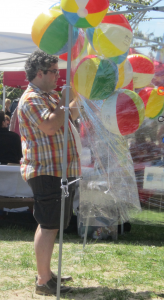 Jeremy Frieburger, author of a report that provided direction for the city’s cultural plan based on reams of data he had gathered. Now the city has to determine how it wants ti implement its Cultural Action Plan. The city has a Cultural Action Plan and a committee that is involved in overseeing the roll out of that plan. One would like to think that having artists sitting on that implementation committee would be a positive sign – and indication that the artists are finally getting the influence they feel they deserve.
Afraid not – there is trouble in paradise.
 The Art in Action Studio Tour is a ten year success. The event is free to the public and there isn’t a dime of public money in the project. Teresa Seaton, who is a significant part of the driving force behind the Art in Action group that holds an annual art tour that is very successful – they have been putting on the event for more than ten years and are financially successful enough to be able to award a scholarship each year, thinks an Arts Council is needed.
Seaton is also a commercially successful Stained Glass artist with a studio in the west end of the city.
On the Collective Facebook page she made some comments … well let’s let Seaton speak for herself:
“Interesting meeting today as a delegate from the External Body Committee to CAPIC -The Cultural Action Plan Implementation Committee. Seems we are still defending the need for an Arts and Culture Council to the city. One of the questions that came up was: What would an Arts and Culture Council do for us, the arts and culture community, in Burlington. As far as I can tell one of the first things an Arts Council would do with funding it hopefully gets is to ask the community what can an Arts Council do for you? And because it seems we are a long way from getting any funding for an Arts Council I thought I might throw up the question here on face book. My personal suggestions…”
An Arts and Culture Council could;
1. Lobby the city to implement, or increase, the already existing public art fee on new developments. I believe the existing recommendation is 1%. I have trouble finding this information.
2. Lobby to lower rental cost for art and culture makers and organizations. No artist that I know can afford retail prices for space. Guess why they all move to Hamilton.
3. Assist arts and culture organization in allowing them access to city printing presses and costs. I know my organization, Art in Action, spends 2,000.00 every year to print its brochures. That money could be used to buy more advertising.
4. Run courses for non-profit organization in gaining more sponsorship dollars. As artists we are not particularly good at this either.
5. Run courses on Succession planning for non-profit organizations. We need help at this.
6. Set up courses for individual artist on social media. How to use it, how to design websites and communicate effectively.
7. Set up forums and try to figure out why the local guilds don’t talk to the local contemporary artists who don’t talk to the local traditional artist who don’t talk to the local crafters who don’t talk to anybody.
 Teresa Seaton – stained Glass artist “Don’t get me wrong; the City of Burlington has come a long way in the last few years. I see the institutions working together more. There seems to be more community involvement in these institutions. But let’s not let this momentum stop.”
CAPIC: the Cultural Action Plan Implementation Committee consists of:
Scott Stewart, General Manager for the city
Angela Paparizo, Manager of Culture for the city
Chris Glenn; Director of Parks and Recreation
Barb Teatero Manager of the Museums Board which runs the Joseph Brant Museum and Ireland House.
Maureen Barry, president of the library
Rossana Dewey, an artist
Trevor Copp, a dancer
Andrea Battista, involved with Symphony on the Bay
Robert Steven, Executive Director of the Art Gallery of Burlington.
Six of the eight people on the committee are bureaucrats – there is no balance here.
The meeting Seaton attended and delegated at also had two other city hall staff and a ward Councillor.
Seaton is quite right when she talks about how far the artists have come – they have risen, literally, and said “we are here and we want to be heard”. And city council, a bit surprised at the artistic energy they didn’t know existed, put money into hiring a consultant who put together a cultural action plan that the city adopted – sort of, and the created a committee to implement that plan.
And that is sort of where things are stuck.
The artists don’t fully comprehend that politicians and bureaucrats do not give away power – they accumulate power and they are for the most part loathe to share that power.
The only way the people (in this case the artists) wrestle power from the bureaucrats is to threaten the power base they have.
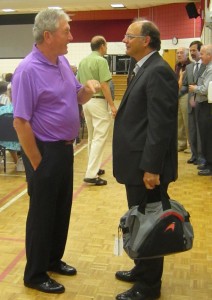 Joe Lamb, on the left, negotiated a deal for the seniors – he didn’t get the kitchen sink because he didn’t ask for it – but he got everything else he wanted. Then city manager Jeff Fielding was told to keep the seniors happy and he did. There is a lesson for the arts community here. A classic example of this was when the seniors began to complain about what they were not getting from the city. They, the seniors, were not happy with the people city hall had sent over to administrate their Centre and they were quick to get on the phone and let the Council members know they were not happy.
The new city manager at the time was sent over to meet and negotiate with the seniors who got everything they had asked for and more. Jeff Fielding, the city manager at the time, was told to meet with the seniors and keep them happy.
Canadians learned yesterday that Canada now has more people over 65 than we have under 14 – the power has shifted to the seniors and they are going to get what they want o they will vote the politicians out of office.
What kind of clout do the artists have? They are creative people with the ability to give the city character, colour, reputation and a reason to visit the place.
The Sound of Music hasn’t learned yet how to use the clout they have. They constantly complain about how little they get from city hall and compare that with how much business they create for that downtown core that is still looking for its vibrancy.
Imagine what would happen if the Sound of Music decided they would not put on their event for a year. You can only imagine the hair pulling that would take place at city hall.
Seaton is right on another level as well; the artists have to begin working like an orchestra and all play from the same sheet music. The squabbling that goes on between the different artists and the different groups is not pretty. They are admittedly high strung people – they go without to be artists but at some point they have to create a united front and use the strength that comes from unity to make their case.
City council has consistently said the arts are important – and they do pump a lot into the institutions we have. The artists want a real seat at the table – they are going to have to require the politicians to walk their talk. It will not be easy – but it can be done – look at what the seniors achieved.

 By Ray Rivers By Ray Rivers
September 28, 2015
BURLINGTON, ON
Ray Rivers has been writing a column on political issues in the province and across the country. The Gazette asked Rivers to drop his regular column and write instead on what took place during the week. This is his third column on the federal election and what has transpired to date.
Since the beginning of this election campaign the NDP have held the lead. This is the first week that polls show their numbers dropping and the party falling into third place. Support for the once-socialist entity seems to be vaporizing across the entire country, including in Quebec. But never say never in an election this close.
In contrast, the Harper Conservatives have picked up steam mid-campaign, making it seem like a Tory minority is in the works, come Oct 19th. And the polls may actually be underestimating the number of seats Mr. Harper will ultimately win.
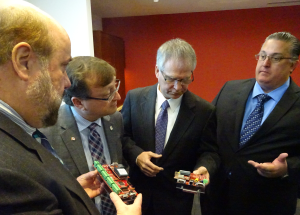 Burlington MPP Mike Wallace, second from the left, taking part in the handing out of federal funds to Burlington industry. For one thing he has more money than the other parties combined, and given the extended election period will assail the other party leaders with a ton of attack ads, which we know work. Then, there is this orgy of recent spending for pre-election goodies in Tory ridings, to showcase, promote and help profile Tory candidates.
Further, Mr. Harper’s government has changed the electoral map to his advantage. With 30 new seats in Parliament it is expected that the Conservatives could win 22 of them, based on the results of the last election. It’s called the ‘gerrymandering’, what his party’s Republican cousins south of the border have perfected, configuring the geography of ridings so the demographics favour the election of Tory candidates.
For example, my riding of Flamborough-Glanbrook was configured by segregating the rural areas from Tory-hostile urban Hamilton. Since rural folks are typically expected to favour Conservatives candidates, the strategy is for the ‘big blue team’ to hold at least one seat in red/orange Hamilton. The riding configuration makes no sense otherwise. It would take longer to drive from one end of the new riding to the other than a trip to downtown Toronto in rush hour.
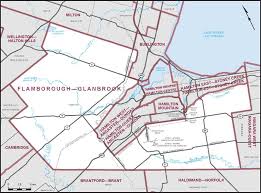 The Flamborough – Glanbrook constituenmcy is a classic example of “gerrymandering” – a form of boundary setting that has little to do with the voters as a community – more to do with putting like minded voters in the same riding to ensure a win for the governing party. Holding the most seats in the House, and unlikely to improve on that, Mr. Harper’s strategy is strictly defensive. So, in an effort to discourage voters who aren’t likely to vote Tory, the government enacted its “Fair Elections Act”. Another idea borrowed from southern Republicans, this legislation sees election rules and responsibilities altered so as to restrict the ability of marginal voters to cast a ballot. And it sure looks like some kind of revenge, that Elections Canada’s powers to police cheating have been curbed.
Speaking of cheating, recall that in 2006 Mr. Harper’s back-room boys broke the election financing rules, enabling them to illegally move money around to expand their campaign. The Conservative party ultimately pleaded guilty to exceeding election spending limits and submitting fraudulent election records, and agreed to repay $230,198.00 for its role in violating Canadian election spending laws.
In the 2011 election a Conservative Party staffer blitzed over 6000 non-conservative voters in Guelph with robocall mis-information in an attempt to keep them from casting ballots. It is thought that as many as 200 voters went to the wrong polling places as a result. There were over 800 complaints to Canada’s election commission over this, and seven ridings sought to have their results overturned.
It’s not that the other parties are always squeaky clean. The NDP recently tried to use public money to mail political flyers. More recently, a provincial Liberal campaign worker was charged by police in connection with last February’s by-election in Sudbury.
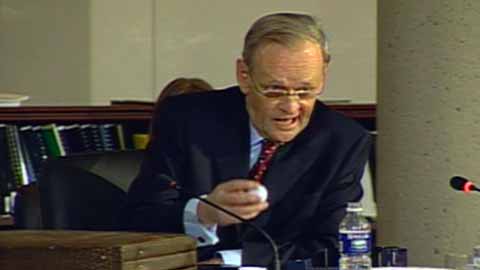 Former Prime Minister Jean Chretien using a golf ball to make a point during an inquiry into federal spending – several senior bureaucrats went to jail for that one. It was not one of Chretien’s finest hours – and Burlington’s Paddy Torsney lost her federal seat over that issue. And then there was the Liberal ‘Sponsorship’ scandal, the consequence of which has seen the federal party lose its place in Quebec politics for the last decade. No other scandal in modern Canadian history has resulted in this kind of rebuff. By comparison, robocalls, a flagrant attempt to prevent voters from casting their ballot, has apparently been forgotten/forgiven.
I watched this week’s debate, in French, since the English language version was virtually unintelligent – with the leaders and moderators talking over each other in both official languages. Mr. Harper joined the Bloc in playing to Quebec’s social conservative base in discussing the Niqab ban, and both parties rose in the polls as a result. Quebecers, and most Canadians apparently agree with the PM on this issue.
Mr. Harper’s self-defence strategy has him feeding his party’s base, hoping to give them enough religion that they will return the faith – showing up on Election Day. To that end he has now added another unenforceable economic policy with the ridiculous name of ‘tax lock’. He is promising no federal tax increases of any kind for the next four years if he wins. This is the second silly shoe, given he’s already passed a balanced budget law – which most experts believe will be broken come year end.
And finally this week, it seems that at least one Hamilton area NDP candidate has reduced her chances of winning over the voters. Alex Johnstone, when
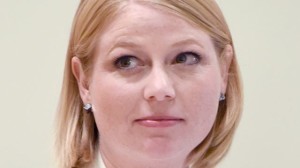 Hamilton Ontario, Sept 22, 2015 Alex Jonstone NDP candidate for Westdale, Dundas, Ancaster at debate Tuesday night in Dundas. Cathie Coward / Hamilton Spectator confronted with an improper remark about Auschwitz she’d made years ago on social media, apologized by claiming she didn’t know it was a concentration camp. I guess this school board official must have skipped that class in candidate college.
 Ray Rivers writes weekly on both federal and provincial politics, applying his more than 25 years as a federal bureaucrat to his thinking. Rivers was a candidate for provincial office in Burlington where he ran as a Liberal against Cam Jackson in 1995, the year Mike Harris and the Common Sense Revolution swept the province. Rivers is no longer active with any political party. Ray Rivers writes weekly on both federal and provincial politics, applying his more than 25 years as a federal bureaucrat to his thinking. Rivers was a candidate for provincial office in Burlington where he ran as a Liberal against Cam Jackson in 1995, the year Mike Harris and the Common Sense Revolution swept the province. Rivers is no longer active with any political party.
Background links:
Seat Projections Redistribution Rural Votes Gerrymandering USA
Fair Elections Act In and Out Scandal
Tory Winning Harper Winning
Spending Money Robocalls
Niqab

 By Ray Rivers By Ray Rivers
September 21, 2015
BURLINGTON, ON
The Globe and Mail held its debate on the economy. This was round two for the three leaders and still, neither a clear winner nor loser emerged. The PM stuck to his mantra that the economy is not great, but that he’s done a pretty good job – he’s not perfect. And despite several well-placed jabs by the opponents, and his ‘old stock Canadian’ slip. some pundits thought he performed the best.
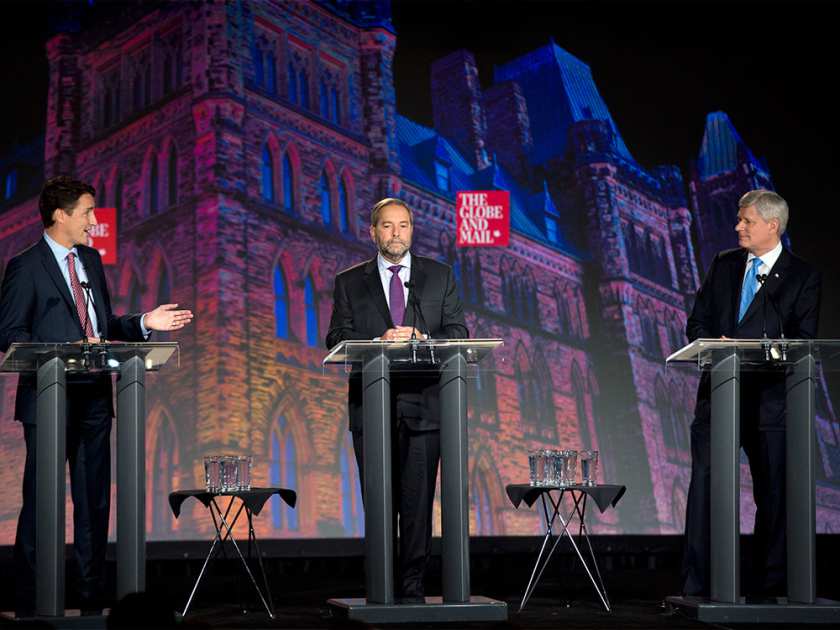 Leaders of the three mainline parties taking part in the Globe and Mail debate on the economy. Green party leader Elizabeth May tweeted about the event – she may have had a bigger following than the one webcast by the Globe and Mail. The way the Nanos nightly polls bob up and down you’d think you were lying, with a good friend, on a water bed. Last night’s poll showed the Tories rebounding slightly as the parties continue this slow dance to the final bell. The CBC’s poll tracker, which uses a weighted average of various polls, shows a tight race with the NDP still in the lead, which is where they have been since the beginning.
The Conservatives wanted this election to be about the economy, so they have run on their record. How is that working out for them? Well, Canada is technically in a recession, the only nation among the G7 to be in economic decline. Unemployment, though near its long term average, jumped to 7% in August. And a small surplus was unexpectedly recorded last year.
A surplus is normally something to be proud of, but not so much in a recession. The announcement sparked criticism that the Tories had deferred spending into future years, just to make the books look good. And others claimed that the surplus had inadvertently contributed to this year’s recession.
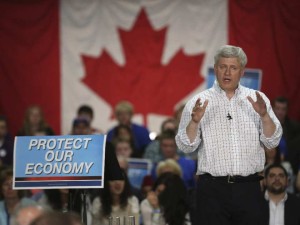 Protecting the economy has been the Conservative pith to voters from the beginning. will it work Mr. Harper claims he is not perfect, but then neither is Canada’s economic condition – what you see is what you get. Still, he has no choice at this point. His last budget is his election platform, notwithstanding the scattering of election goodies he announces every few days or so.
The NDP’s Mulcair is shadow boxing. This is particularly true in Ontario where the words NDP are inextricably associated with high taxes and high deficits – the ghost of a government punching above its weight during one of Canada’s worst recessions. So he’s decided to play it safe, buying into the PM’s budget, using it as his own platform.
Not to appear too cozy with the PM, he has tried to personalize it with his own list of goodies. And, his biggest promise, the $15 day national day care plan, will be just a pipe dream unless all ten provinces ante in. Otherwise he might as well be campaigning with the PM.
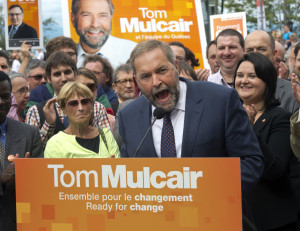 Federal NDP Leader Tom Mulcair speaks to supporters at a rally where he promotes his view that the country is ready for a change. it appears to be working Last week Mulcair unveiled his ‘fiscal plan’ essentially a ‘back-of-the-envelope’ summary of how he would alter the last Tory budget to make it his own. For example, he added extra revenue from raising the corporate tax rate and subtracted revenue loss from cutting the small business rate before summing the difference.
And all three leaders are now promising to do something to lower the small business tax rate. That would be a progressive measure though it is questionable how much small business investment and job creation would spring forth as a result. Taxes are only one factor affecting small business decisions of investment and hiring, and not the most important one.
Consumer demand is the key determinant for small business expansion and that means a healthy growing economy. If you can’t sell your product, because people aren’t buying or they’re buying cheap imports, then how much tax you’d have to pay on your profits is the last thing you’d worry about. The best policy to help small business is for government to help the economy out of the recession, deficit or not.
Mr. Mulcair is the only major leader planning to raise corporate taxes. One should wonder why all the leaders are not promising to do that. Canada’s corporate tax rate is the lowest in the G7 by a good measure. Further, there is no proof that the government revenue forfeited by lowering corporate taxes can stimulate the economy any better than direct investment in public goods like infrastructure – or cutting the HST. Didn’t we learn a while ago that ‘trickle down economics’ doesn’t work?
Do Mr. Harper and Mr. Trudeau really believe that lowering the taxes of the banks and insurance companies, so they can cut their CEO’s even fatter bonus cheques, really helps our economy? How can these leaders reconcile the dramatic slashing of corporate tax rates over the last decade with the evaporation of some 400,000 manufacturing jobs over that same time period?
Mr. Harper has been criticized for using an unrealistically high oil price as the basis for revenue projections in his budget. That shaky, disingenuous foundation stone for his plan has been ignored and glossed over by Mulcair’s steely-eyed strategists, it appears. As a result Mr. Mulcair’s fiscal plan can be made to balance, just as easily as the PM’s. It is such irony to hear Mr. Harper claim that NDP will be running deficits, knowing that is also in his cards.
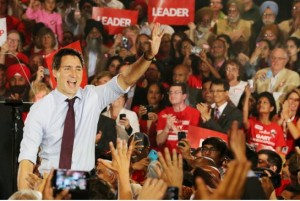 Justin Trudeau believes the country needs economic stimulation and is prepared to live with deficits to revive an economy that is technically in a recession and has an unemployment rate that is rising – every so slightly. Unlike the other two leaders Mr. Trudeau isn’t pretending he can run a surplus with imaginary numbers. He’s set a spending target for Canada’s much needed infrastructure investment and… to hell with the deficit, at least for the near future. Unlike the other leaders, Mr. Trudeau has come out of his corner making no pretence that he can balance an unbalance able budget.
 Ray Rivers writes weekly on both federal and provincial politics, applying his more than 25 years as a federal bureaucrat to his thinking. Rivers was a candidate for provincial office in Burlington where he ran as a Liberal against Cam Jackson in 1995, the year Mike Harris and the Common Sense Revolution swept the province. Rivers is no longer active with any political party. Ray Rivers writes weekly on both federal and provincial politics, applying his more than 25 years as a federal bureaucrat to his thinking. Rivers was a candidate for provincial office in Burlington where he ran as a Liberal against Cam Jackson in 1995, the year Mike Harris and the Common Sense Revolution swept the province. Rivers is no longer active with any political party.
Background links:
The Economic Debate Key Debate Points – Nanos Poll Poll Tracker
Unemployment Numbers – Mulcair’s Fiscal Plan – Mulcair’s Critique – More Mulcair –
Actual Plan Small Business Tax Corporate Taxes
Trickle Down Economics

 By Pepper Parr By Pepper Parr
September 15, 2015
BURLINGTON, ON
The phony election phase is now behind us. The past few days there have been more promises from the four parties wanting to either ensure they stay in power or want to form the next government and exert the power the public gives them. And remember – the power a government has is power you gave them when you voted.
Burlington has a large seniors’ population; current MP Mile Wallace has courted that cohort very successfully and they have been loyal to him. Say seniors and you have also said pensions, and that has brought out a statement from Liberal candidate Karina Gould who today said: A Trudeau-led Liberal government will make sure that Canadian seniors get the secure and dignified retirement they deserve.
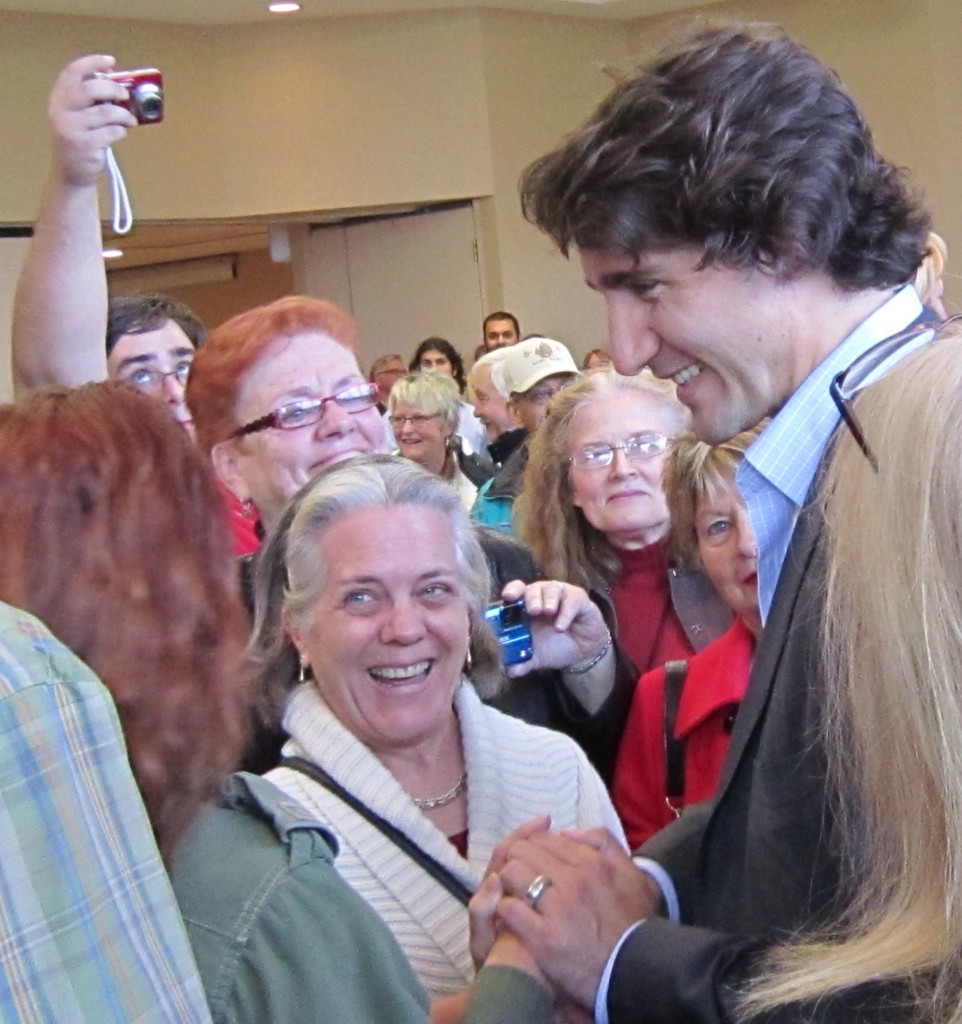 These seniors are certainly fans of Justin Trudeau – he draws well when he is on public tour. Many of his policy statements have been strong – knowing how it is all going to be aid for is a concern. It isn’t just the Liberals who aren’t being candid about the costs. “With record levels of household debt and an economy in recession, it is no wonder why Canadians in Burlington – and across the country – are worried about their retirement,” said Gould. “Right now, on average, a retired person receives just $618 per month from the Canada Pension Plan – hardly enough to live on. Our seniors have worked their entire lives, and should not have to struggle to make ends meet. Justin Trudeau has a plan to ensure that all Canadians get the dignified retirement they have earned.”
“As part of our three-point plan to create jobs, grow the middle class, and help those working hard to join the middle class, a Liberal government will work with the provinces and territories to significantly reform our retirement security system by:
• Restoring the eligibility age for Old Age Security and the Guaranteed Income Supplement to 65;
• Lifting hundreds of thousands of seniors out of poverty by immediately boosting the Guaranteed Income Supplement for single low-income seniors by ten percent;
• Introducing a new Seniors Price Index – in recognition of the fact that many seniors live on fixed incomes – to make sure that Old Age Security and the Guaranteed Income Supplement keep up with rising costs;
• Beginning discussions with the provinces and territories, workers, employers and others on how to enhance the Canada Pension Plan within our first three months in government;
• Not cutting pension income splitting for seniors;
• Introducing a more flexible and accessible Employment Insurance Compassionate Care Benefit; and
• Prioritizing significant new investment in affordable housing and seniors’ facilities as part of a Liberal government’s commitment to a new, ten-year investment of nearly $20 billion in social infrastructure.
This is good stuff – and as a senior who looks for that pension cheque going into the bank at the end of every month I certainly understand who Gould is talking to – me.
How is my government going to pay for this improvement in my pension? Are they going to have to take money away from something else? Will the much touted federal day care program be lost for another decade? Will the aboriginal communities not get the schools they desperately need so I can get a bigger pension?
Governing is a balancing act – how do you keep everyone happy?
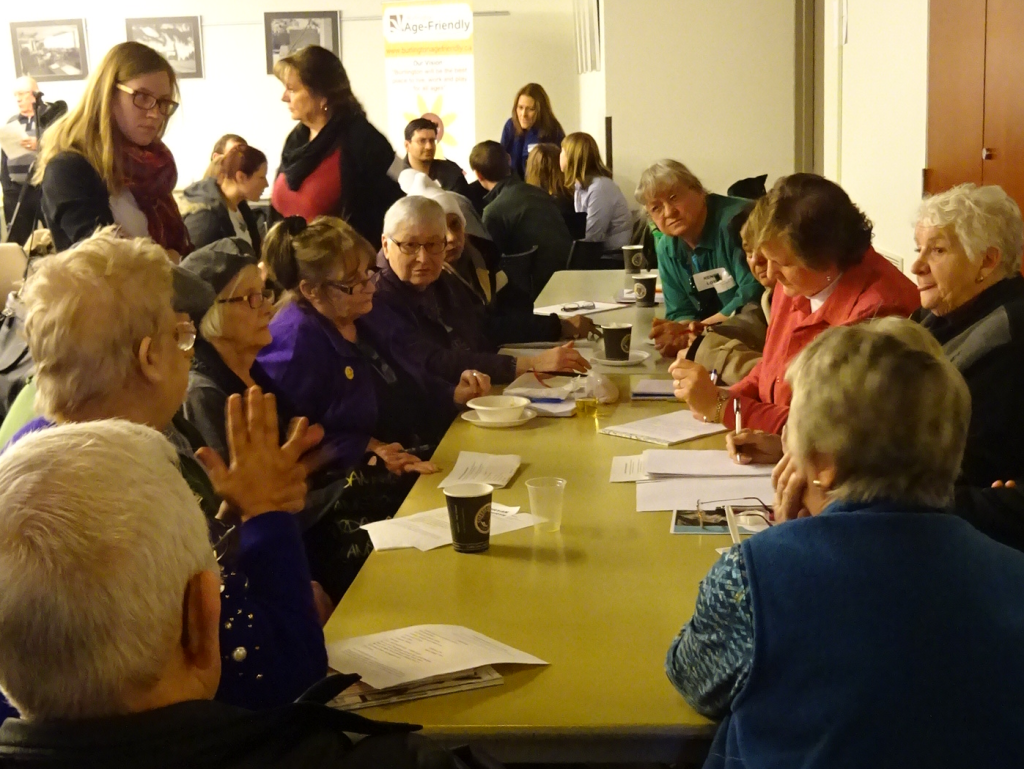 Liberal candidate Karina Gould watches a group of seniors discuss transit policy – getting around the city is critical for these people – just as critical as their pensions. “I’m proud of the policy my Party announced today for seniors,” added Gould. “It is a product of grassroots discussions, like the town hall I held in January with the Hon. John McCallum, Liberal Critic for Citizenship and Immigration, Multiculturalism, and Seniors. The measures we’re putting forward are born directly out of these conversations. I have been listening to the serious issues that face seniors in our community. I’m proud to stand for a party that will act for all of our seniors and ensure a dignified retirement for everyone in our community.”
I too am proud of the policy – I’d just like to know how it is going to be paid for.
The Liberal candidates are not the only ones a little shy on the details side of the election promises – a voters question should be ; how much?

 By Staff By Staff
September 13, 2015
BURLINGTON, ON
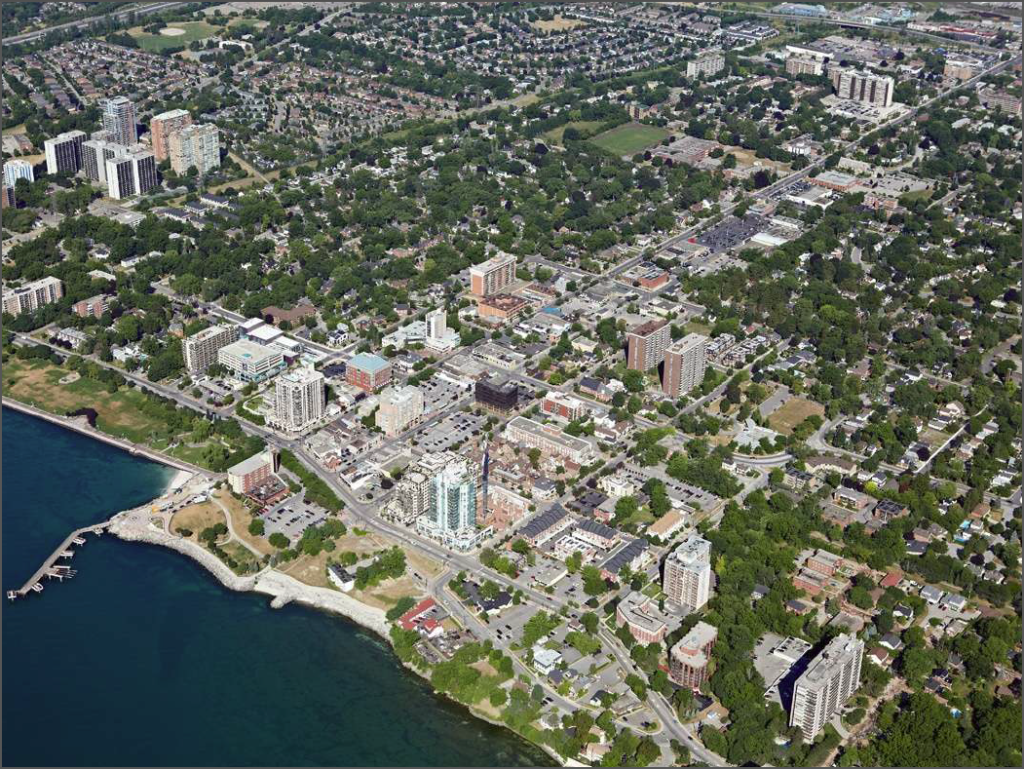 Are Burlingtonians fairly taxed – on reader doesn’t think so. The comments section of the Gazette usually has boisterous debate – several of them write far too long but those that participate in the comments return again and again.
This came in earlier today. A reader said:
Toronto Star, on September 5, published a Home of the Week. It is located in North York, 3,300 sq. ft, 5 bedrooms, 4 bathrooms. with a pool, and a toboggan hill. It sold for $1,729,000.
Taxes are $5,747. I have a small, frame, 1,509 sq ft bungalow in Burlington, assessed at $709,000 which pays $14,433 (including BIA and a commercial surcharge).
Even assuming that 1/3 of my tax is commercial, my Burlington property pays almost double the rate of a North York property valued at much more than double my valuation. This is crazy.
Why should it cost over 4 times as much here as in Toronto?
Interesting question. Our reader should pull the belt in another notch – you are likely to be taxed even more next time around,

 By Ray Rivers By Ray Rivers
September 13, 2015
BURLINGTON, ON
Each week between now and the day we all vote, October 19th, Ray Rivers is going to give Gazette readers his take on how the election is going. The week that was will appear every Monday morning.
This was the week of the the ‘Mansbridge Moments’, the CBC’s National program of interviews with the leaders of the three main parties, and the Green Party’s Elizabeth May. Much as with the candidate debates, a rarity despite this exceptionally long campaign, the winners and losers will be found in the eyes of the beholders.
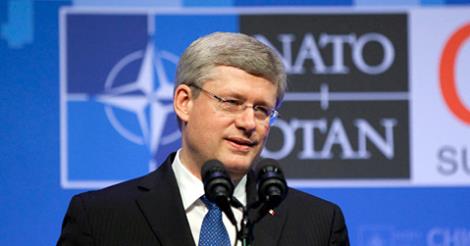 Stephen Harper – on the ropes today – but don’t sell this man short. I thought Mr. Harper looked tired, and resigned to the fact that his party has now dropped clearly into third place. A new air of humility, possibly him test-marketing the new Tory strategy, ‘Harper’s not perfect’, was in play. However, after his opining about the consequences of a Tory loss, one would be pressed to doubt his sincerity.. Mr. Harper has also parked his old campaign team and embraced a new hired gun to save his failing campaign. Perhaps that announcement alone was behind his strengthened numbers as the week closed.
The ‘Wizard of Oz’, as he is called is responsible for the winning campaigns of David Cameron in the UK and Tony Abbot in the Wizard’s own native Australia. He will have his work cut out for him to effect a mid-campaign correction for Mr. Harper, however. After all, this was a campaign meant to highlight the PM’s strengths as a man of principle, an accomplished economist and a purveyor of security. But that was before the Duffy fiasco, the economy hitting the skids, and the messy refugee crisis.
Topical columnist Margaret Wente has called him toast, what we do with stale bread. And Michael Coren took the time to write a column to let the world know that he couldn’t possibly vote for Harper because he is not a real Christian. After all Christians are supposed to steward the planet and pay regard for the meek who will inherit it.
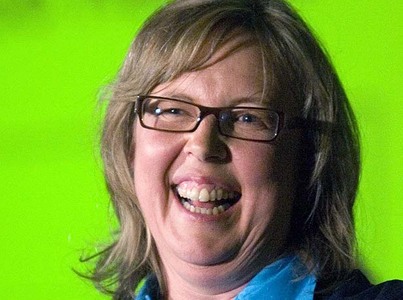 Seem by many as a smart strategic thinker who adds value to the House of Commons – and thinks she might end up holding the balance of power on the day after the election. Elizabeth May unveiled the most progressive policy agenda of the campaign. Free tuition, national high speed rail, the end of fossil fuels, and global leadership on climate change – what’s not to like? But then she knows she won’t be PM this time around. So she might as well be promising us perfect beauty and eternal life, oh and a place in Mr. Coren’s Heaven for the PM. May sees herself as a match maker, as a kind of Lava-Life or, dare I say, Ashley Madison; who can mediate the two left-wing parties into an unorthodox alliance – a same-sex marriage of sorts.
And Mr. Mulcair has sworn to wait for ever at the altar, though Mr. Trudeau would need to be dragged screaming. What unites these three opposition parties is their determination to end Harper’s reign. And they are not alone, the Bloc’s Gilles Duceppe and another sixty plus percent of Canadians feel the same way.
There are significant policy differences for the two leading opposition parties, despite agreement on restricting tax free savings, enriching the Canada Pension Plan, killing income splitting, and saving the environment. Still, though Mulcair is promoting his $15 day-care plan, the balance of his socio-economic program, so far, looks a lot like what Mr. Harper has been doing. His commitment to balance his first budget as Canada goes into recession, without even knowing what the real numbers are, looks a lot like risky business.
Mulcair didn’t have a good answer for how he’d get his agenda, including abolishing the Senate, past a potentially hostile Senate. And he hasn’t even got a lick of NDP in the red chamber to plead his case. Then there is the 50.1% vote he claims he’d accept for Quebec’s separation. A legacy of the Layton era, maintaining this promise is disingenuous to Quebecers and the rest of Canada, given the decision of the Supreme Court and his own history fighting against separatism.
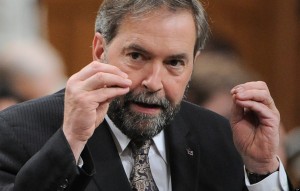 NDP leader Tom Mulcair asks a question during Question Period in the House of Commons on Parliament Hill in Ottawa, Ontario, on Monday, May 14, 2012. (AP Photo/The Canadian Press, Sean Kilpatrick) Unlike Mr. Harper he was upbeat and positive in his Mansbridge monument, something one would expect from someone leading in the polls. But he seemed to smile too much, likely to compensate for criticism of bearing a too-serious, almost dower, natural pose. But at least the smiling did detract from the fur on his face, which every woman I know thinks he should shave. But he was articulate, thoughtful and engaging enough to make people want to like him, even if they’ve never trusted his party before.
Mr Trudeau was enthusiastic to the point of being almost bouncy. It is hard not to think of the ‘not ready’ ad the Tories have been running, but then we should understand that his age is but a stone’s throw from that of Obama, JFK or his own father when they were first elected. And Mr. Harper, who became PM in his mid forties, is the proverbial pot calling the kettle.… Recall that though PET governed us sternly throughout the FLQ crisis, he also played – for example, doing those famous pirouettes or that ‘fuddle cuddle’ thing..
Trudeau promised to reverse the growing concentration of power in the prime minister’s office, a trend his father had initiated in order to improve the work of government. The alternative is a government which runs the risk of contradiction and in-fighting. While Harper is a control freak, it is the cloak of secrecy and reign of terror he has cast over the entire public service that is so damaging. Demoralized and overworked staff are behind the recent failures in the immigration department, for example.
Like Harper, Trudeau’s not perfect. He miscalculated in offering limited support for the Tories’ police state legislation, Bill C-51. It was a political gamble which cost him support both within and outside of his party, possibly one of the reasons for his decline in popularity after having led the polls for most of last year. He claims he’ll fix that though.
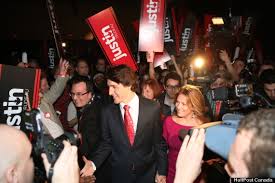 The country watched as another Trudeau headed towards the leadership of a political party He is bold, and boldness is on the other side of stale toast. Voters want change in this election. Ms. May could be the outlier of that change, but Trudeau is a close second, staking out some new ground by offering to re-balance the income tax act in favour of the middle class. He has gone where no one else has gone by embracing a deficit needed to build badly needed infrastructure and grow the Canadian economy out of its recession.
As a consequence his party has bounced back and is now firmly in the second spot of this tight three-way race. Apparently Mr. Mulcair has more goodies up his sleeve and both opposition leaders are promising a fully costed policy platform before balloting time. And then there will be all that new wizardry from the Harper camp.
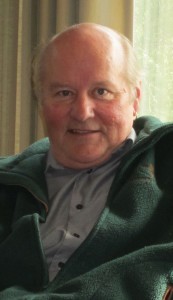 Ray Rivers writes weekly on both federal and provincial politics, applying his more than 25 years as a federal bureaucrat to his thinking. Rivers was a candidate for provincial office in Burlington where he ran against Cam Jackson in 1995, the year Mike Harris and the Common Sense Revolution swept the province. Ray Rivers writes weekly on both federal and provincial politics, applying his more than 25 years as a federal bureaucrat to his thinking. Rivers was a candidate for provincial office in Burlington where he ran against Cam Jackson in 1995, the year Mike Harris and the Common Sense Revolution swept the province.
Background links:
Christian Thing to d Toast
Mansbridge Moments Polls The Wizard of Oz More Wizard
Harper Not Perfect

 By Pepper Parr By Pepper Parr
September 11, 2015
BURLINGTON, ON
There is more to the Advanced Manufacturing hub the ¨Prime Minister announced with great fanfare in Burlington recently. The City’s Economic Development Corporation has been working on the project for some time; their approach is to do away with the fanfare and let the results of their efforts speak for themselves.
“When we have something to say that is relevant” said Fran McKeown, Executive Director of the not for profit organization “you will hear from us”.
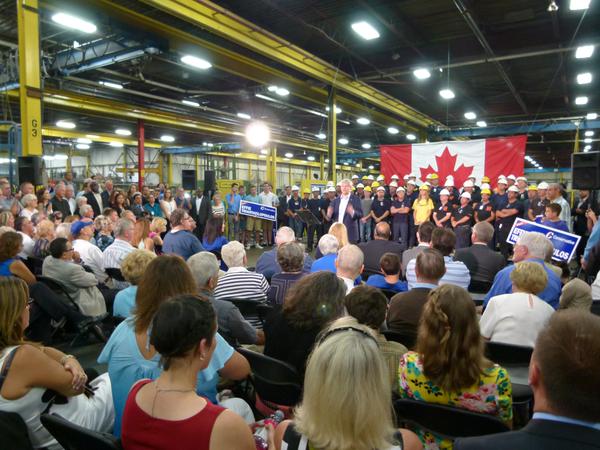 Prime Minister Stephen Harper speaking to a hand picked Burlington audience. The Gazette got a note from Tony Araujo, Vice President – Testing, Paragon Systems, Concord, ON. Here is what he had to say:
I read your story on the Prime Minister’s announcement of a new “Advanced Manufacturing” hub for Burlington and was shocked that the Conservatives would do this again! I’m already fighting the last “investment” this government made in London’s Advanced Manufacturing Park.
In March 2015, Industry Canada’s FedDev Ontario gave Fanshawe College an $8.1 million gift to set up a for-profit commercial testing lab on land provided to the college for free by the City of London. The Canadian Centre for Product Validation (CCPV) will compete head-to-head with existing private sector testing labs throughout Ontario using students as labour.
FedDev Ontario’s own analysis of Fanshawe’s CCPV business plan even concluded that it would “adversely affect” the existing 30 private sector testing labs that “currently serve Ontario industries quite well”.
$8.1 million is bad enough. $100 million will be the death of my business and the 32 jobs that we currently have in Vaughan.
As a small business person, I expected this kind of crazy policy from the NDP, certainly not from the Conservatives.
Is it any wonder the electorate thinks that the Conservatives have lost touch with their values?
There are usually several sides to every story.

 By Pepper Parr By Pepper Parr
September 8, 2015
BURLINGTON, ON
The first in a series on the Burlington trustees on the Halton District Board of Education.
In the next 120 to 150 days 11 people are going to make a choice that could change in a very meaningful way how the municipalities of Burlington, Oakville, Milton and Halton Hills are seen by the rest of the province and perhaps the rest of the country.
Trustees Kelly Amos, Oakville; Amy Collard, Burlington; Joanna Oliver, Oakville; Leah Reynolds, Burlington; Donna Danielli, Milton; Andrea Grebenc, Burlington; Ann Harvey Hope, Oakville; Richelle Papin, Burlington; Kim Graves, Milton; Jeanne Gray, Halton Hills and Tracey Ehl Harrison, Oakville are the elected members of the Halton District School Board and they as a group will vote on who they want to lead the development, administration and delivery of education in the Region.
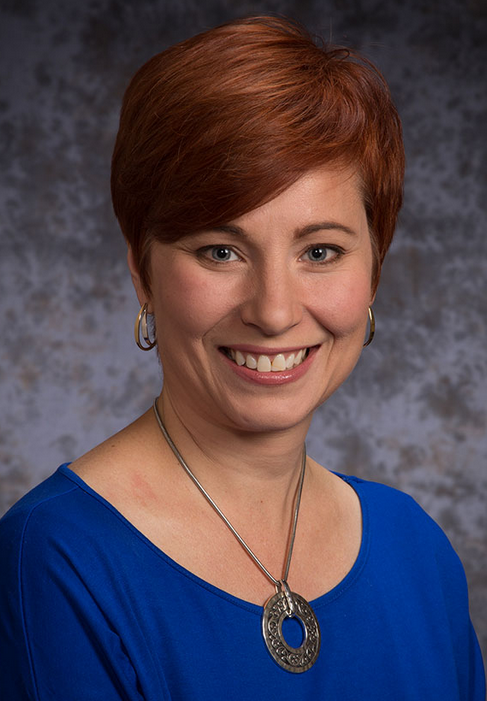 Andrea Grebnec – Burlington Trustee  Amy Collard – Burlington Trustee 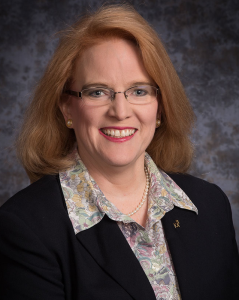 Anne Harvey Hope – Oakville trustee Burlington let itself get caught up in the promotional hype of a magazine that chose the city as the best mid-sized city to live in. That Burlington was chosen was due in no small measure to the persuading former Mayor Cam Jackson laid upon the publishers of the magazine. Jackson convinced them to see Burlington as a separate entity and not lump us in with Hamilton – when that was done Burlington began to look much much better.
For a time that line “the best mid-sized city in Canada” was parroted by members of city council as if it was something we had earned – it was an award made up by a magazine to promote their circulation,
There are many many things about Burlington that are positive. But the city doesn’t have much in the way of a provincial or a national profile. Oakville is known for all the people with bags of money that live there and Milton is known for its explosive growth – they also have an Olympic grade Velodrome that was their benefit from the Pan Am games – all Burlington managed to get was a cheque for renting out the City View Park for Pan Am soccer practice.
Burlington seems to want to focus on its geography – the Escarpment to the north and the lake to the south and that’s about it. A nice, for the most part, comfortable community that has its share of problems that it seems to muddle through.
Hamilton is entering a phase that has some buzz to it – the end of their steel manufacturing stage has begun and they are in the process of re-inventing themselves. Two decades from now Hamilton will be THE place to live in Ontario.
As for Burlington – there is an opportunity that is now in the hands of the 11 people who have been elected as school board trustees.
Current Director of Education for the Halton District School Board David Euale has resigned and the search for his replacement is now down to the short list.
 Donna Danielli -Milton trustee 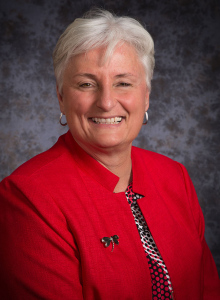 Jeanne Gray – Halton Hills trustee Burlington is the kind of city people like to live in – it is safe, not particularly exciting but a reasonably easy place from which to get to Toronto. But is there a really strong reason to live in Burlington? – it certainly isn’t the cost of housing.
But Burlington could be the city that has the best public education school board in the province. Schools matter to parents – just look at the number of private schools in the Region.
Those eleven school board trustees have the opportunity to put Halton on the map – and by extension Burlington as well.
There are schools in this city that parents will actually cheat to get their children into – Tuck is one of them. Why do they do that? Because the principal of that school has made it one of the best in the city.
Why is Nelson High School the superb institution that it? Why is Bateman such an excuse for a high school? (That is a person opinion – I have had dealings with the leadership at that high school and this is an opinion column.)
It all comes down to leadership – there are great leaders in the public education system and they are always looking for a great board of education to work for – there aren’t a lot of them around.
Imagine what could happen if the trustees made it known that they want the best person there is to lead their board. To say publicly and loudly that they want an education leader who will not only improve our rankings but develop schools where every principal is not only a leader but an innovator.
 Kelly Amos, Oakville trustee and current chair of the board  Kim Graves, Milton trustee 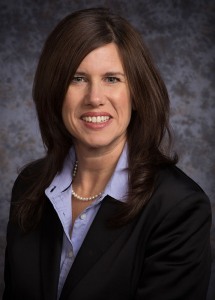 Leah Reynolds – Burlington trustee A director that knows how to motivate and to take risks and create schools that students are excited to go to each day. A leader that has standing and a profile in the community – a leader that has a grip on the changes taking place in the flow of information that young people have coming at them.
A leader that develops high schools that produces Rhodes Scholars – Halton has apparently produced one Rhodes Scholar.
A leader that has high schools that graduate students who are almost automatically accepted at universities because they came out of the Halton school board system.
There is a line in our Bibles about Daniel from which the phrase “Dare to be a Daniel” has come. “God gave Daniel a special task. He boldly accepted the assignment and God used him to change an entire nation!”
As our trustees begin their task of determining who the next Director of Education should be one hope that they will dare to be Daniels.
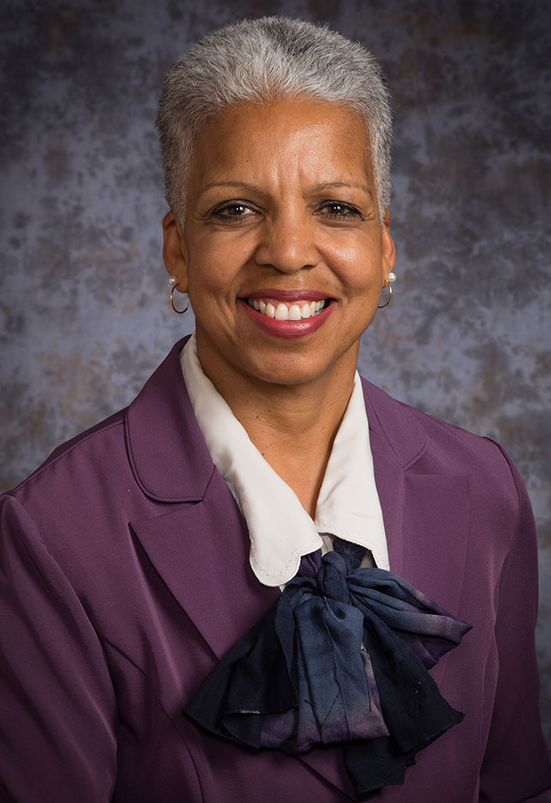 Richelle Papin – Burlington trustee  Tracey Ehl Harrison, Oakville trustee A significant step has already been taken in creating a leadership team at the board in the appointment of Jaqueline Newton who has been appointed the Superintendent of Education. Ms Newton was the woman tasked with opening Hayden High school – she did a superb job there and we believe will do an equally superb job with the Board. A Director of Education made from the same mold would be nice.
There are eleven people in the Region who have the power to do just that. If they aren’t all that close to their Bibles perhaps they can fall back on the Nike advertising slogan – Just do it!

 By Ray Rivers By Ray Rivers
September 7, 2015
BURLINGTON, ON
Each week between now and the day we all vote, October 19th, Ray Rivers is going to give Gazette readers his take on how the election is going. The week that was will appear every Monday morning.
Thanks to a reader it has been brought to my attention that the report of the father of the drowned refugee child refusing Canadian citizenship was false, despite its broad reporting by media including the CBC and National Post. Please disregard that line in the column for that reason and if interested please take the time to consult….
Note from that website that…”As National Post editor Jen Gerson suggests, the blunders in reporting this breaking news story do not change the core substance of it: the drowned boy whose picture made the world suddenly care about the refugee crisis might have found refuge in Canada. His family had tried. Our Immigration Minister was directly approached about this specific case.
The story would have been no less impactful had it been reported accurately, and there is no evidence to suggest that the mistakes were made out of partisan bias or intent to sensationalize or deceive. They were mistakes, which often happen in breaking news stories.”
Thanks again to readers who take the time to contribute to the discussion. It is exactly for situations like this that I include my primary source
Ray
Advertising – it’s what chews up so much of the money in election campaigns. And, of course, it usually works, though not always as expected. For example, the Conservative ads prior to the last election in 2011, implying that Liberal leader Ignatieff had returned to Canada out of opportunism rather the welfare of Canadians, may have helped knock the Liberals into the Parliamentary basement.
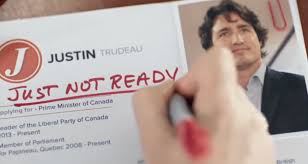 This advertisements did some damage – will it come back to haunt the Conservatives? This time the Tories have taken aim at another Liberal leader, Mr. Trudeau, claiming that he is ‘just not ready’ to be PM. And one pollster is claiming that it has already been effective in dissuading otherwise Liberal voters. Of course, that seems to fly in the face of the latest CBC ‘poll tracker’ which has the Liberals slipping into second spot, ahead of their Tory arch-enemies and closing the gap with the front running NDP.
One has to recall how the Conservatives blew it big time when Kim Campbell was running in 1993. Tory strategists, including the current Toronto mayor of the same name, had ordered up a series of four ads depicting Mr. Chretien as unsuitable for the big job. The images used were unflattering, highlighting a childhood illness which had left him slightly disfigured.
Despite protestations by her campaign team, Campbell pulled the ad in response to a chorus of public protestations. But it was too late and the Conservatives were decimated at the polls, dropping to only two seats.
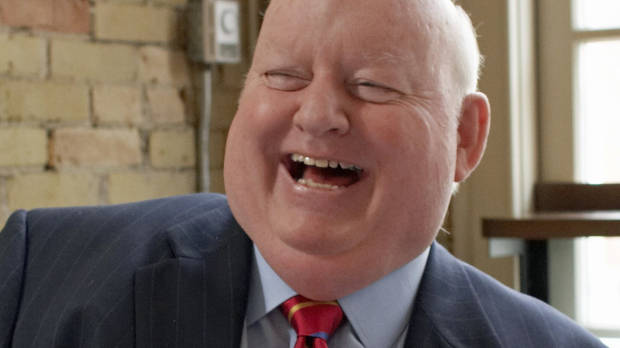 Mike Duffy is on trail – hard to realize that with the way the proceedings in the courtroom are going. Mr. Harper’s drop in the latest polls reflects a campaign gone awry. The Duffy Senate scandal is still in people’s minds and nobody believes that Mr. Harper didn’t know about the payment nor try to cover it up. If anything will tick off the public, it is an almost never-ending stream of lies.
Then there is the sad state of the economy, covered in my regular column a week ago. The PM’s has been cherry-picking the statistics to put on a happy face on what is pretty clearly bad news – but nobody is buying.
Most recently Canada’s failure in the Syria/Iraq refugee crisis has demonstrated an inexplicable level of incompetence in administration and policy. The minister, Chris Alexander, clumsily and stupidly attacked the media while being interviewed on CBC’s ‘Power and Politics’. The next day, in an admission of his failure, Alexander postponed campaigning so he could return to his office to fix what he should have taken care of months earlier.
This issue has come back all the way to Harper heartland. While other Calgarians were protesting the refugee mess, the City’s popular mayor, Mr. Nenshi, added his voice. He attacked the PM’s response to the crisis and Alexander’s performance. Nenshi demanded bringing back ministerial responsibility and accountability, code words for somebody needs to be fired.
And that would be the Minister, who is apparently unable to answer Nenshi’s questions on how many refugees Canada will accept or even how many have been admitted so far. Meanwhile the father of the drowned young boy, who has brought this issue to light, is so upset he has turned down a belated offer of Canadian citizenship.
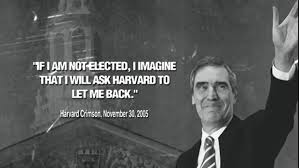 As a political advertisement – this one worked. Iggnatief lost his own seat and did indeed return to Harvard University – truth in advertising? Also newsworthy, the PM’s wife, Laureen, appears to disagree with her husband’s views on Marijuana and his so-called ‘tough on crime’ mandatory sentencing policy. And then, the Conservative internet folks seem to be unable to locate and use the right images to go along with their social media stories. One would expect such sloppiness from a losing campaign.
And nobody, it seems, wants Mr. Harper to lose this election more than newly crowned Mrs. Universe. Ashley Burnham, a Canadian of Cree origin has called on the country’s first nations to help vote him out of office.
 Ashley Burham, a Cree, was named Miss Universe – and is not a fan of the Prime Minister – thinks she can persuade the Aboriginal community to vote this time and vote for someone else Finally, there is pee-gate. Yes, the Conservative candidate in a Toronto area Riding is caught on camera urinating into a homeowner’s coffee cup and putting it back in the sink, while doing a home repair (his business line). This story is now trending on Twitter and prompting one tweet, “Too bad the Conservatives are no longer progressive, so we could argue whether Jerry Bance is a small p or big P candidate”.
If Mr. Harper’s house of cards includes using his considerable financial capability, particularly during this super-long election campaign period, to fill the airwaves with attack ads, he is in trouble. He knows the opposition can’t match him with attack ads of their own. But with all the bad news the PM has been generating his opponents don’t need them.

Ray Rivers writes weekly on both federal and provincial politics, applying his more than 25 years as a federal bureaucrat to his thinking. Rivers was a candidate for provincial office in Burlington where he ran as a Liberal against Cam Jackson in 1995, the year Mike Harris and the Common Sense Revolution swept the province. Rivers is no longer active with any political party.
Background links:
‘Just Not Ready’
Mulcair is Ready
Poll Tracker
Chretien Ads
Nenshi
Laureen
Social Media Sloppy
Mrs. Universe
Refuses Citizenship
Pee in a Cup

 By Ray Rivers By Ray Rivers
September 4, 2015
BURLINGTON, ON
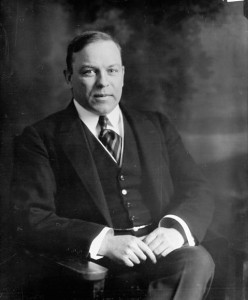 Prime Minister McKenzie King introduced the first pension plan. It’s the closest we come to socialism, excepting welfare and universal health care. The old age pension, a national universal pension was first established in 1927. William Lyon Mackenzie King delivered on his campaign promise to create Canada’s first national pension plan. It was modest and income-weighted but welcome relief for Canada’s needy seniors, allowing them to live out their remaining years in dignity, or at least out of starvation.
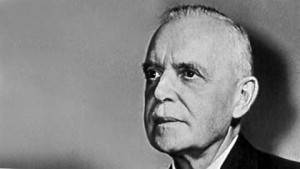 Prime Minister Louis St. Laurent improved on the Canada Pension Plan McKenzie King created. In 1952 Louis St. Laurent reformed the pension program, which had barely survived the great depression and WWII, into today’s Old Age Security (OAS). Over the years the OAS has been tweaked, adding an income supplement for those in need, reducing eligibility from 70 to 65 years of age, and inflation-proofing it through indexation. Mr. Harper has partially reversed these progressive changes by deferring OAS eligibility by two years to 67, while his predecessor, Brian Mulroney’s 1985 attempt to remove indexing collapsed before a crack squad of raging grannies.
The OAS is not the only retirement goody that Ottawa offers. There are registered retirement savings plans (RRSPs), initiated by Diefenbaker, which allow deferred taxation; registered interest tax-free savings accounts, started by Harper; and the Canada Pension Plan (CPP), established in 1965 by Pearson. But unlike OAS, which is essentially a welfare program for seniors, these are contributory plans, though the CPP is co-funded by employers.
 It is something everyone is going to need – make sure you are satisfied with what whichever government we elect is giving you what you think you need. Unlike the OAS which is an entitlement, the pensioners actually are owed the money socked away in these plans, something governments sometimes seem to forget. For example, since Canada has no inheritance tax, the government requires us to continually reduce the value of our RRSPs beyond age 71, whether we need the money or not.
And then there are the myriad of private plans, more now being offered as ‘defined contribution’ rather than ‘defined benefit’. These plans are typically managed by intermediaries, insurance companies or mutual fund managers, who invest the retirees’ future into the vagaries of the market for better or worse, depending on whether the market and interest rates are up or down.
There are so many opportunities for today’s seniors to harvest their retirement earnings that Maclean’s Magazine ran an article (September 15, 2014) titled “Old, Rich and Spoiled”, claiming that today’s retirees are “the most prosperous generation ever”. Despite the inflammatory headline there is no doubt this generation’s seniors are better off than preceding ones. But there are still seniors living below the poverty line and surveys show there is great financial insecurity among a majority of Canadians being put out to pasture.
 Notrel in its day was a great multi-national company that failed to keep up with a rapidly changing technology – it also failed to ensure that its pension obligations were met – the provincial government had to pick up that tab. Private company pensions look good if you worked for the right company, the one that might still be in business through your retirement, unlike we saw with Stelco or Nortel. Even my former employer, the federal government, unilaterally decided to downgrade my superannuation package recently. If you can’t trust the feds to keep their word, who can you trust? In the case of Nortel, the Province has had to take over paying the retirees.
And that is part of the reason why Ontario’s premier, after petitioning the federal government to ramp-up CPP – and being shown the door – is developing her own pension plan, the ORPP. Notwithstanding her understanding that an enhanced CPP would be a better route to go for national portability and consistency, she has little choice but to go it alone. And the provinces have primary jurisdiction over labour matters, which is why Quebec has its own version of CPP.
As a result the provinces can find themselves bailing out defunct pension plans for companies, like Nortel, when they go belly up. Then Ontario also has been topping-up the federal OAS, through its GAINS program. So it has a legitimate dog in this issue, a right to protect the lot of Ontario seniors. And there is broad support for change in other provinces beyond Ontario, judging from the interest the Premier has churned up with other provincial leaders in the Council of the Federation.
Ontario’s plan would only apply to those currently without a company pension plan. It would ‘level the field’ with employees in the banking, insurance, municipal, teaching, and civil service sectors of the economy. Someone who has been employed for 30 years would typically receive 60% of his/her salary as a retirement pension, as most of the institutional plans offer.
But Mr. Harper will have none of it, refusing to change CPP and even refusing to help Ontario reduce the costs of its planned ORPP by harmonizing it with the CPP for collection and management. That is something which would cost the federal government very little but would save debt conscious Ontario from setting up a duplicate bureaucracy.
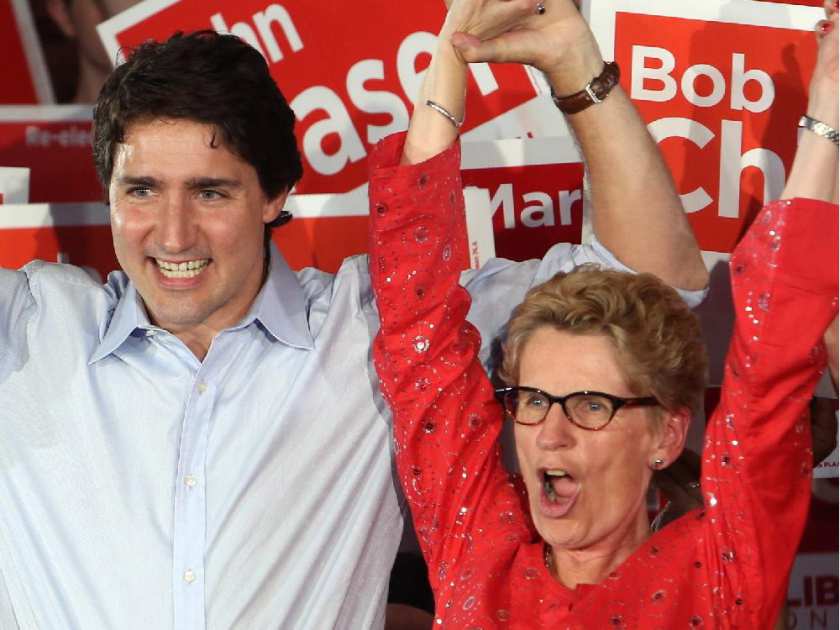 They needed each other on the pension issue – will the Ontario idea of a provincial pension plan prevail? Quebec has its own pension plan. The federal plan as it stands now is not meeting the needs of many Canadians. Whatever Mr. Harper’s reasons, he is using Canada’s seniors and future seniors, as fodder in his war against Ontario’s premier. As could be expected, Premier Wynne has responded in kind, directly supporting Liberal leader Justin Trudeau, who has committed to modernizing the CPP. And justifiably, since so much of Canada pension framework of was developed by Liberal governments.
The PM is right that refreshing the CPP will add costs to the employers’ payroll, though it should allow the eventual phasing out of the myriad of piecemeal company plans. And that will reduce labour costs for business in turn, while enhancing labour mobility.
Come voting time, pension issues may well be a low priority for young families struggling to manage new families and their first home, where every dollar counts. And the issue will have little, if any, direct payback for seniors already living through their golden years. But making our income systems more equitable and secure is an issue that affects us all as a society.
Fortunately there are clear choices on this issue in front of the voting public. In that regard, Mr. Mulcair has announced that he would call a provincial-federal meeting to reform the CPP within six months of becoming PM. Given his persistent ranking at the top of the opinion polls that must be music to Premier Wynne’s ears, though we shouldn’t expect her to also campaign for him.
 Ray Rivers writes weekly on both federal and provincial politics, applying his more than 25 years as a federal bureaucrat to his thinking. Rivers was a candidate for provincial office in Burlington where he ran as a Liberal against Cam Jackson in 1995, the year Mike Harris and the Common Sense Revolution swept the province. Rivers is no longer active with any political party. Ray Rivers writes weekly on both federal and provincial politics, applying his more than 25 years as a federal bureaucrat to his thinking. Rivers was a candidate for provincial office in Burlington where he ran as a Liberal against Cam Jackson in 1995, the year Mike Harris and the Common Sense Revolution swept the province. Rivers is no longer active with any political party.
Background links:
OAS Canada’s Pensions World Pension Systems
CD Howe on Pensions Mulcair Harper
Federal Pensions GAINS ORPP Wynne

 By Staff By Staff
August 21, 2015
BURLINGTON, ON
Mark Carr got word that the program he moderates on Cogeco Cable “The Issue” was good to go for the fall.
 Cogeco’s The Issue panel: Mark Carr, host on the left with Casey Cosgrove, a guest, then former Mayor Walter Mulkewich and then Brian Heagle First show for this season of The Issue is Tuesday September 15th 8pm LIVE.
The show is interactive – twitter them at # The Issue.
The Issue is broadcast on channel 23 and channel 700 for high definition.
Carr monitors the twitter feed and bounces comments tweeted in with the panel made up of former Burlington Mayor Walter Mulkewich, lawyer and former Burlington council candidate Brian Heagle, and Deb Tymstra who has reported for Cogeco on a number of issues.
The intention is to have a guest on the panel as well. The publisher of the Gazette has been asked to take part in the panel from time to time.
Those watching the program can tweet comments and see how the panel responds.
You can agree or disagree with the panel of community/political experts live” said Carr “ and then watch to see how they respond to what you had to say.”

 By Jim Riley By Jim Riley
August 20, 2015
BURLINGTON, ON
Kyle Tonkens uses approaches of both Performance Art and Installation Art in his most recent artwork, entitled “The Funeral Procession of the Beloved Departed”.
Performance Art is a non-traditional art form that uses two or more arts: these could be acting, painting, poetry, dance, music, etc. My own perspective focuses on the visual impact of the performance.
 Family and friends were invited to the funeral of the Dearly departed Henrietta Markham. Performance Art often uses symbolism and concepts that are difficult for some to comprehend without supplementary information. It can be like trying to read a foreign language without translation notes.
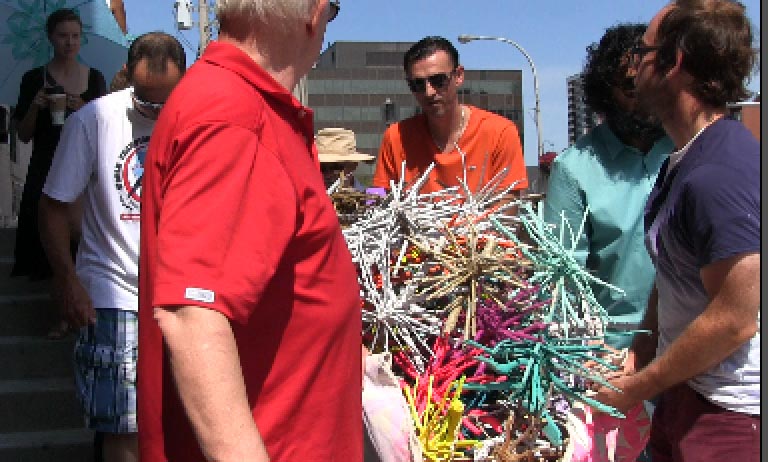 The funeral cortege proceeded along John Street on its way to the Art Gallery of Burlington. “The Funeral Procession for the Beloved Departed” started on John Street, Burlington. People gathered in celebration of a person’s life, and participants were encouraged to recall their own loved ones. Tonkens referred to the procession being for all our beloved departed, but referred specifically to a woman named Henrietta Markham, and quoted her poetry. Henrietta was Tonkens’ grandmother. During a recent interview, Tonkens disclosed that he used Henrietta’s “voice” in presenting his own poetry. This is in accord with his belief that all things in life and death are interconnected – which is a key concept of the exhibition.
In the middle of the John Street room there was a mound of what the artist had previously referred to as “hand-bound wood rosebuds constructed of gathered sticks and bound together by jute twine and wire”. The rosebuds are painted in solid bright colours creating a colourful mound. Some guests were given neon-coloured rosebuds, or a painted parasol, to carry in the cortege.
Aaron Zukewich played music on his soulful saxophone in the room, and during the procession.
They bore the funerary mound down John Street and along Lakeshore Road to the Art Gallery of Burlington. Once at the RBC Community Gallery, the mound was gently placed with five other mounds on the floor. Those who had carried painted rosebuds and parasols from John Street placed them on one of the six funeral mounds.
Some of the mounds had darker painted rosebuds or natural wood, symbolizing those separated from us some time ago. The contrast between the brightly coloured rosebuds and the earth-toned rosebuds gave the impression of after-life energy that was still within the mound and had not yet departed.
 The mandala-like, neon-coloured wall paintings are partly mirrored by the lines on the parasols. The artist refers to the painted walls as incorporating “the flower of life pattern”. This resembles Hindu mandala symbols — geometric and very spiritual. The three mandala-like, neon-coloured wall paintings are partly mirrored by the lines on the parasols. Umbrellas with a similar appearance are suspended from the ceiling: they represent the spirits, after release from life, connected to the mounds.
The Performance Art drew a crowd of participants. Tonkens did not venture too deep into the non-traditional inter-art practices of performance art. It was intriguing how he straddled non-traditional and traditional art and their approaches to the subject. Conceptually, Tonkens is exploring complex issues that might not easily be communicated to many of those present. The cortege was somewhat like a New Orleans funeral procession, but the music played was more solemn and mournful. It felt ritualistic, in a metaphysical way.
At the AGB, the artist continued his performance by greeting and thanking the participants as one might at a funeral. Tonkens’ belief is that we should be truly grateful. What makes Tonkens’ performance differ from other memorial services is that he gave some of the audience members a gift of a small, square acrylic painting, signed by Henrietta Markham, but done in his style.
Tonkens’ giving of gifts has a sacred aspect. His use of this concept dates back to his 2013 “The Spirit of Death Watching…” performance during his No Vacancy installation. This gift-giving is reminiscent of northwest indigenous potlatch ceremonies. The purposes are similar, in emphasizing the grateful acknowledgement of major life changes such as birth, marriage and death. Tonkens’ ritualistic gift-giving emerges as the strongest element of his performance art practice.
Installation art is sculpture, but the audience is inside the artwork rather than observing from outside. The entire space of the room defines the sculpture’s boundaries. The placement of objects or people within the room is significant to the 3D composition of the work. Each person entering the gallery becomes another part of the sculpture as they walk through the installation of materials, light and colours – not intended to be explored passively from the outside edge, but actively from within.
How successful has Tonkens been with his installation?
 The parasols were carried from John Street and placed on one of the six funeral mounds at the AGB Tonkens’ suspended painted parasols with curved lines are symbiotic with the wall paintings. The suspended umbrellas integrate successfully the visually awkward ceiling fan into the installation. They break up the aerial space, adding unity to the entire experience. The installation might have been stronger if the ceiling parasols and mounds had been varied more within the room. Changing the scale and location of some of the mounds might have had more visual impact for the viewers, and easier access for closer examination of the mounds.
The RBG Community Gallery’s physical limitation makes it a challenge for installation art. It is a former café, and there are too many windows, plus a drop-tile ceiling and fans.
This installation might have been more successful if the artist had closed the blinds and used a more dramatic lighting technique on the mounds and wall paintings. The existing lighting does not adequately support the concepts. However, it might be argued that these options were beyond the artist’s control. I suspect that the AGB is working on improving this new community space, but labours under budgetary limitations and physical restrictions such as concrete walls.
The quality of art presented in the new AGB Community gallery has varied in the past from very professional works to child art, focusing on thematic community-based exhibitions. Kyle Tonkens is evolving as an emerging professional. I look forward to seeing his future presentations, as he is unique among the members of Burlington’s arts community.
Kyle Tonkens most recent performance art installation is on view at the Art Gallery of Burlington until September 13, 2015.
 Jim Riley is a Burlington-based video artist, independent curator and arts writer. Jim Riley is a Burlington-based video artist, independent curator and arts writer.

 By Pepper Parr By Pepper Parr
August 10th, 2015
BURLINGTON, ON
The Premier and a couple of her Ministers are going to announce some of the design features for the Ontario Retirement Pension Plan that Kathleen Wynne thinks the citizens of Ontario need.
And why is that news? – Because we are in a federal election campaign and Wynne has made it clear that she is going to work very hard to get Liberal leader Justin Trudeau elected.
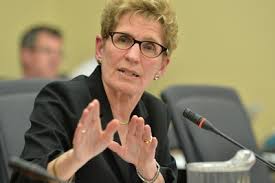 Wynne feels something has to be done to improve the pensions that people will need when they retire and because the federal government has shown no interest in making it possible for people to add to what they set aside for future pensions – the province of Ontario has to step in and do something – now. Wynne feels something has to be done to improve the pensions that people will need when they retire and because the federal government has shown no interest in making it possible for people to add to what they set aside for future pensions – the province of Ontario has to step in and do something – now.
Wynne has been banging away at Prime Minister Harper for months to get him to hold meetings with all the Premiers – not something he is interested in doing. So Wynne announces that she will hold a press conference to talk about the “design features” of the pension plan she wants to put in place.
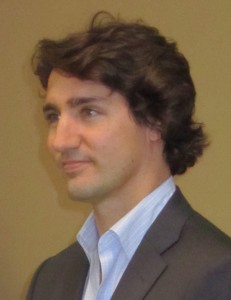 Is he what we want? The name doesn’t hurt – now what has he got in the way of ideas? Of course should Justin Trudeau manage to become the Prime Minister all the work Premier Wynne has had done will be set aside and the new federal government will make changes to the current Canada Pension plan – which is what should have been done in the first place – but the current Prime Minister doesn’t want to be seen cooperating with Liberals and certainly not with Kathleen Wynne.
These politicians do play games.
We’ll let you know what the Wynne pension plan design features look like.

 By Pepper Parr By Pepper Parr
August 1, 2015
BURLINGTON, ON
The City of Burlington has received complaints from a number of residents regarding what they believe to be disturbing material delivered to their mailboxes.
In a statement from the city, it is not attributed to a specific person, the city said it is not in a position to affect the distribution of these materials and add that they have received the following statement from Canada Post:
“We are responsible for the physical delivery of all mail in Canada. We do not have the legal right to refuse delivery of a mail item because we or other people object to its content. Anyone who has concerns about the content should either contact the publisher or simply dispose of it.”
And that’s it – not another word. The Gazette has received dozens of complaints and comments on this repugnant literature.
 Some of the comments on social media: Some of the comments on social media:
“You know what really sucks about this all? The images are very painful reminders for many parents who never had a choice. This organization is obviously run by a group of uneducated, immature kids with too much money to blow on junk mail.”
“Well that was nice. My 13 year old just handed me the flyer during dinner. She fished it out from behind a desk because she was worried her 9 year old brother would see it and be scared. Disgusting.”
“Us too. Beyond disgusting and obviously oblivious to the fact that this government just legalized the pill version of said procedure.”
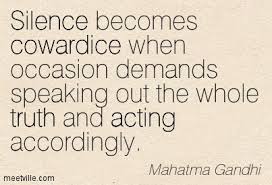 There are thousands of comments like this being made on social media. What we haven’t seen or heard are public statements from the office of the Mayor expressing concern over what can only be described as vile. There are thousands of comments like this being made on social media. What we haven’t seen or heard are public statements from the office of the Mayor expressing concern over what can only be described as vile.
There is such a thing as community values that are put forward by our leaders be they political, pastoral or prominent people who have earned the respect of the community.
This is the time for these men and woman to stand up and express the dismay, disgust and inappropriateness of this kind of stuff on behalf of the community.
Most people have a view on abortion; many people discuss this subject amongst themselves and arrive at a moral decision they are comfortable with. My own view is that life is the biggest gift mankind has been given and when it is forsaken – let us not demean it with photographs that can only harm.
To attach the face of a person running for the leadership of the country to this smut is as low as one can get. This is not what political debate is about.
Councillor Sharman did have conversations with the police who told him there was nothing they could do. Councillor Sharman could have said publicly that the distribution of this kind of material was unacceptable and that he wanted the public to know it was beneath the values of the community he represents.
When we do not stand up for our values – we lose them.
Related articles:
Is it hate mail? It is certainly disgusting.
Sick minds that sink below common decency.

 By Pepper Parr By Pepper Parr
July 26, 2015
BURLINGTON, ON
It is difficult to find a developer in the Burlington area who will say great things about the city. It is easy to find developers, particularly the smaller ones, who do not have a complaint they are quite ready to share with you.
The “counter” – that’s the place developers first go to when they want to talk to people in the planning department, is often the focus of the complaints.
Developers will complain that they can never get a straight answer from the planning department and that just when they think they have everything the city needs in the way of reports – they find that yet another report is needed.
The planning department doesn’t see it quite that way – but they didn’t want to talk for attribution.
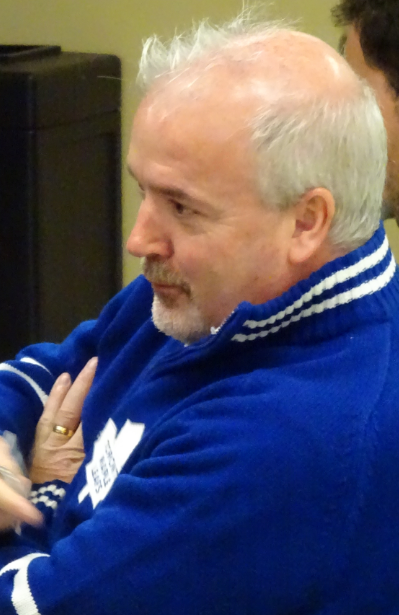 Scott Stewart loves that sweater – has he had it since 1967? Scott Stewart, the General Manager for Infrastructure and Development is serving as the Interim Director of Planning – and he is a lot different from the recently retired Director of that department.
Stewart wants to see a culture change within the department and has moved some people around and adds “there are some noses out-of-place” in the department but there will be a change”.
The bringing in of a new director for planning is a Stewart hire to make and he is pretty clear in his mind what the city needs.
James Ridge, city manager, has some planning experience in his background – he and Stewart should be on the same page on this one.
Burlington’s city council members don’t, at times, fully appreciate the command structure at city hall. Council hires the city manager and he runs the city for them. Council creates policy and issues Staff Directions – the city manager follows those directions.
The city manager is there to advise and guide council – but the marching orders come from Council. Decisions get made by city council based on policy and specific votes made by the seven council members.
They don’t do the actual hiring – a source has suggested to the Gazette that the Mayor wanted to be in on the actual interviewing of the short list for the director of planning – that shouldn’t happen.
The story is told, from a sterling source, of the Council member who said he thought Council should be involved in the hiring of everyone down to the Director level. The person who told the story said to the council member: ‘You clearly have no concept of what staff accountability is all about.’ With this Council it is referred to as “getting into the weeds”.
Most municipal governments have well qualified, committed professional staff. They do have a pension that is not available to most people and it might seem as if they get a lot of time off. When senior staff are taking part at public meetings in the evening – are they required to be at their desks first thing the next day? Many people in Burlington think they should.
When the budget is going through its final phases – the team that creates that document, based on instructions from city council, work well into the night frequently to complete the budget.
Whoever the city hires as its next Director of Planning, hopefully will be with the city for several terms of office. The elected officials come and go – in Burlington they don’t seem to go very often which is unhealthy but until the voters in town decide they want different leadership we’ve got what we elected.
There is a bit of a leadership crisis at city hall; there are culture changes that need to be made in several of the departments.
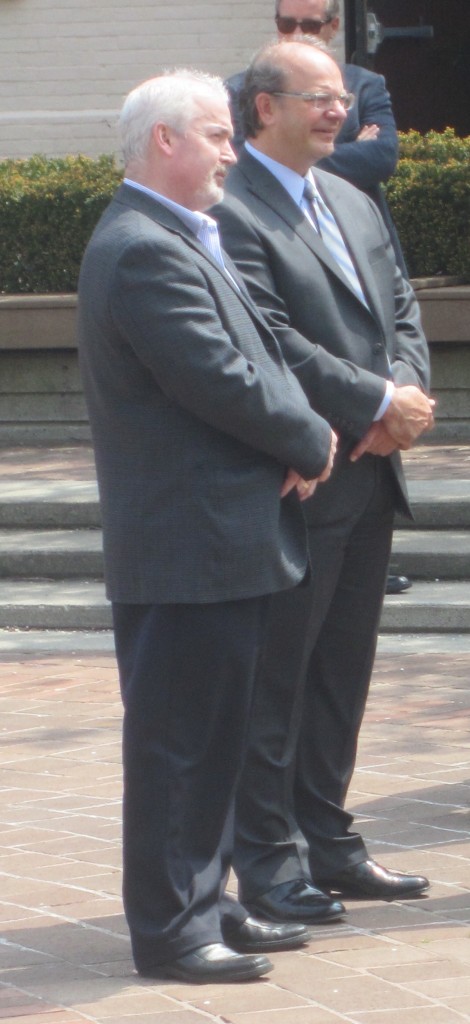 Scott Stewart on the left,and former city manager Jeff Fielding, put a number of major changes in place – but then Fielding saw a greener pasture and headed west for Calgary. Burlington has had three city managers in five years plus an interim filling the chair until a new city manager was hired.
Every management leader needs time to create the kind of work force and working environment that results in the kind of service delivery the public wants. Some good people have left the city for other jurisdictions because the lack of solid consistent leadership that would allow them to grow as civil servants wasn’t in place.
Burlington now has a city manager who has yet to make his mark. James Ridge isn’t a Jeff Fielding, his predecessor. He is more cautious and quite a bit quieter and appears to be a stickler for the rules. A deal maker he isn’t.
We need another year of observing Ridge to get a clearer sense as to what kind of a staff he wants to have in place to deliver the program he understands the city council wants.
We have watched Ridge admonish this Council ever so slightly when they appeared to be resisting the making of a decision. Ridge will, in his quiet way, hold their feet to the flames.
Ridge is not a big believer in the concept of Master Plans – Burlington has been in love with the things for years.
Ridge thinks they create silos and he seems to want a more homogenous approach to the way staff think through their problems. It is going to take him some time to determine where staff changes have to be made and then implement those changes.
Fielding was exceptional at getting out and talking to people; you always knew when he was in the room. Ridge is a quieter person – we are only beginning to get a sense of his decision making process.
Council has handed him a hot one – the Code of Conduct that has been kicking around for far too long and should have been agreed upon by this Council at its last meeting. Some fancy procedural foot work on the part of Councillor Sharman, aided and abetted by Councillors Craven and Lancaster, to reverse a change that had been agreed upon at Standing Committee preciously resulted in the whole matter being referred to the city manager who would work with it as part of the governance section of the Strategic Plan.
Strategic Plan sessions are frequently, if not always, done off site or in a room at city hall where there is no web casting capacity.
The scallywags on this council like it that way. It’s going to be messy.
Staff observes these changes and turn to their city manager to save them from this kind of unprofessional behaviour.
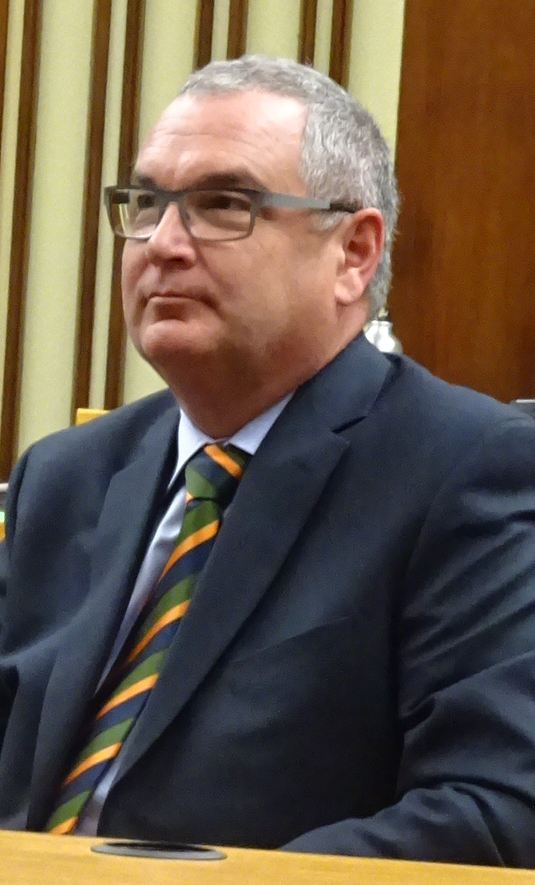 James Ridge the day he was introduced to the public at a council meeting – he didn’t say a word. Is Ridge up to the job – can he manage the Mayor and the rest of |Council and hold a draw a clear line or will he choose to become “friendly” with council and fetch water for them rather than pour cold water on silly, expensive ideas that they come up with and expect him to find the money to pay for
James Ridge has the summer to work this one out. How he resolves this will tell what kind of a city manager we have; what kind of a culture will prevail at city and what kind of a city we end up being. This assumes that he completes his five-year contract.

 By Pepper Parr By Pepper Parr
July 8, 2015
BURLINGTON, ON
What if the transit drivers decide they want to force their issues and walk off the job Monday morning – the 13th
Transit people will tell you that once a bus rider leaves it takes a long, long time to get them back.
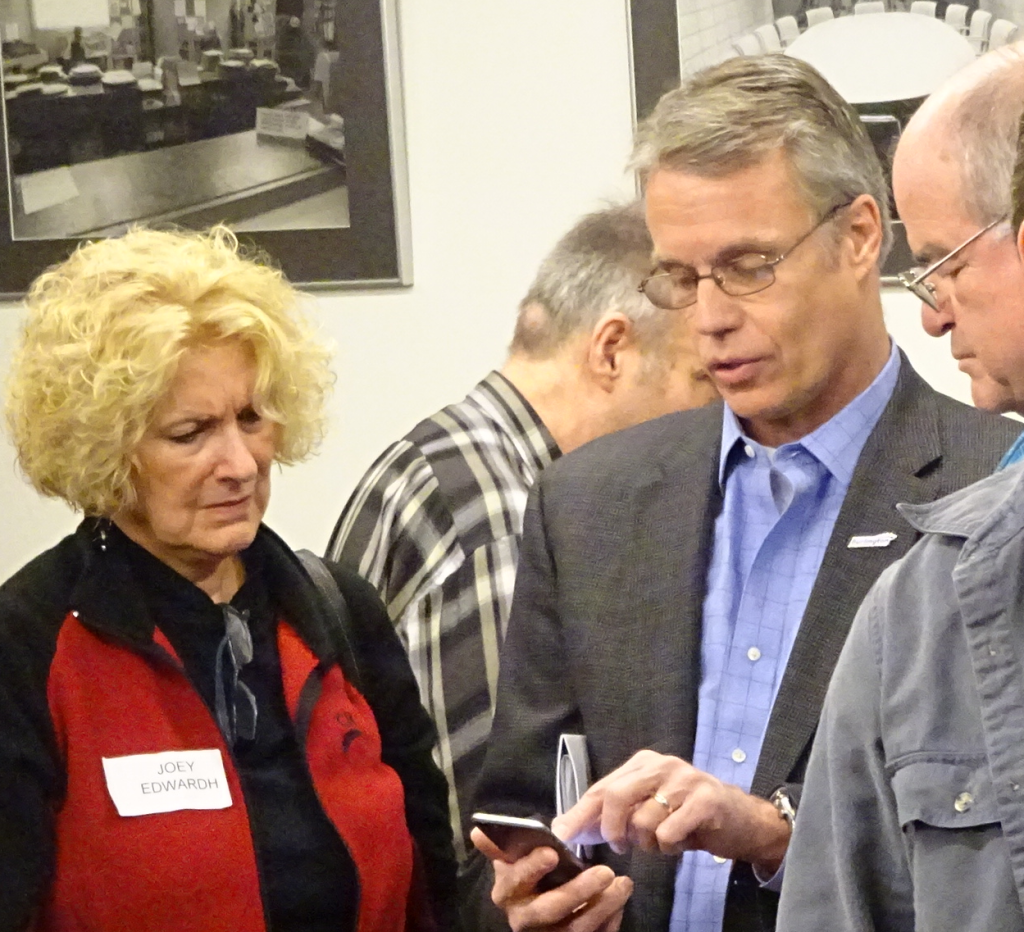 Mayor explains using the bus schedule on his cell phone Riders are forced to find some other way to get around – and they often like what they find – even if it costs more and they stay with it for some time.
There is a break in the trust that existed between the transit drivers and those who use the buses.
People who depended on transit had their lives significantly disruptedand they don’t see their transit driver as the friendly person who they met and chatted with every day.
There is a disintegration in public trust – something that is hard to quantify or measure but it is certainly there.
Burlington is not a transit friendly city. There are people who will be delighted when the bus no longer drives by their house making more noise than they want to put up with.
Those same people don’t like the noise the garbage truck makes but they put up with it because they want their garbage removed.
They are not transit users and they resent the amount of their tax dollars that are used to support transit – they see transit that is something for people of limited means – and they don’t see Burlington as a city of limited means.
This attitude is part of a particular demographic – it isn’t seen in the younger people – they adapt more easily and tend to have a different take on the damage that cars do to the environment.
It will be interesting to see what the transit workers decide to do and how city council reacts.
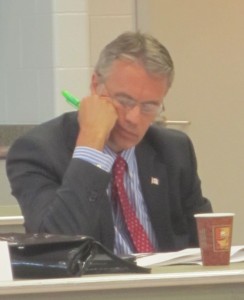 Mayor thinking through a problem – transit is going to occupy some of his thinking this weekend. 
 By Pepper Parr By Pepper Parr
July 2, 2015
BURLINGTON, ON
What have we managed to do as a country in this past 148 years? Stay together is perhaps the biggest part of our success as a country.
Getting the Maritime provinces and what was then the Province of Canada to agree to form a confederation in 1867 was propelled to a considerable degree by the Civil War the Americans were fighting at the time.
 Fathers of Confederation negotiating in Charlottetown, Prince Edward Island. Once Confederation took place Ontario and Quebec were created and the task then was to bring in the rest of the country – everything west of Ontario
We didn’t get Newfoundland into confederation until 1948.
Then in 1995 Quebec missed leaving the confederation by less than 50,000 votes. They had failed to separate in 1980 as well. Many feel the issue of Quebec becoming a spate country is now behind us – we certainly won’t fight that battle for another twenty years. And who knows what kind of a country we will be then?
We are now an ethnically diverse country. An aggressive immigration policy has moved Canada from a French and English country to one that has people from every imaginable country.
We have in the past shown the ability to bring in tens of thousands of people who faced disasters in their own country. The “boat people” from Vietnam was perhaps one of our best moments as a compassionate caring people.
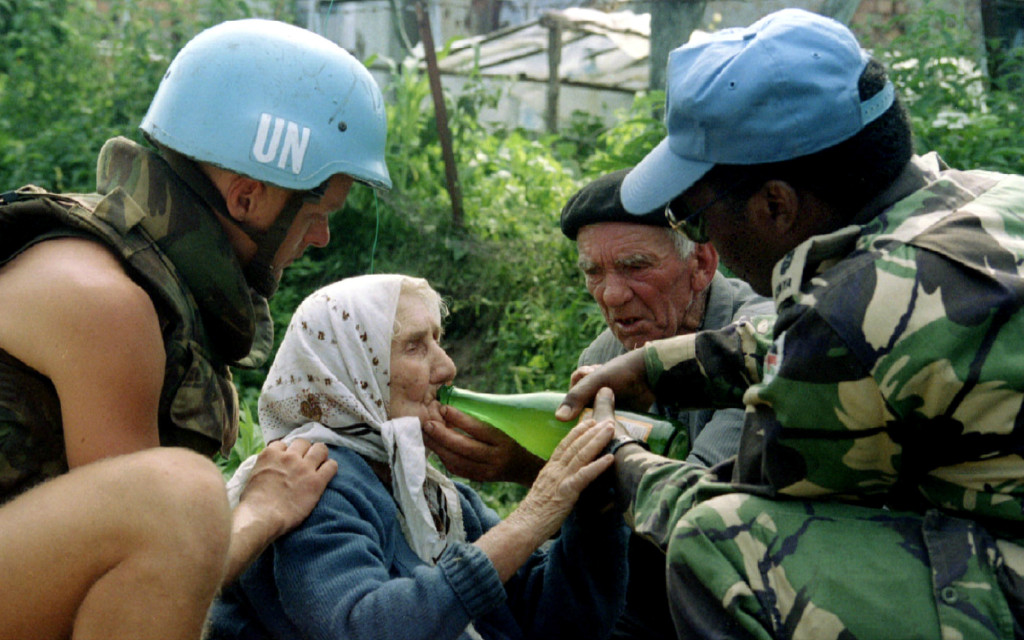 United Nations Peacekeepers were the result of a Canadian resolution at the UN. Were respected leaders then. The creation of the United Nations Peace keepers was another proud significant time for Canadians.
We have been a country that has gone to war when we felt it necessary – and came close to fracturing the country when Quebec saw both the first and the second world wards differently than the rest of the country.
We overcame those difficulties as well.
We have not become known as a country with strong environment positions. We have failed to live up to the various accords we have signed.
 Some of the dirtiest oil on the planet comes out of Alberta We mine and ship some of the most toxic oil this planet has seen; some of that oil will in the not too distant future run through a pipeline at the top of this city.
Why Canada is not a leader in the environmentally sound refining of the tar sands oil is a national shame. It is the federal government that holds all those cards.
John Kennedy made America the world leader in space exploration when he said they would put a man on the moon in ten years. It became a mission for that country and they succeeded.
Imagine if our federal government did the same thing with the oil in Alberta? We could have billions of barrels of oil flowing out of the tar sands and into refineries and transported around the world.
There is more oil in our tar sands that there is in the ground in Saudi Arabia – we are an oil rich nation but we insist on selling dirty oil to people that need oil badly.
We have not been as judicially sound as we have been in the past. Our Supreme Court is constantly at odds with the federal government.
We have treated our aboriginal people very poorly in the past and are still doing so to this day. Changes are beginning to take place but the price aboriginal people have had to pay while the rest of us began to learn and understand how badly our governments treated these people has been very high.
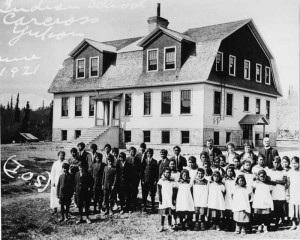 To our everlasting shame – we did this to our aboriginal people – some thought we we doing the right thing. Most people didn’t even know what was being done. Many aboriginal communities are seriously dysfunctional and we blame that dysfunction on the racist belief that these people are not ready to govern themselves. We have been wrong in the past and we are wrong now.
Some of our police forces are beginning to look a little like those south of the border. We treat our criminals so badly that they remain criminals for as long as they live. Punishment is part of behaviour change but there are limits which our federal government doesn’t appear to understand – they just keep opening up more prisons and treating those in prison in a manner that all but guarantees they will return soon after they are released.
And we spend a princely sum to keep convicts in prisons but won’t spend an amount anywhere near on a national day care program.
As a society we have yet to realize that no one was born a murderer or a bank robber – the society we are played some part of what happened to turn an innocent into as criminal.
 As we move closer towards a critical election in just over 100 days this might be a good time to reflect on the Canada you want and which government you believe will get us all there. As we move closer towards a critical election in just over 100 days this might be a good time to reflect on the Canada you want and which government you believe will get us all there.
In two years we will have been a country for 150 years – will we be different then?

 By Staff By Staff
June 30th, 2015
BURLINGTON, ON
What does $50 million worth of red tape look like?
If you’ve ever had to fill informs for any government agency – city hall for that matter – you know what I’m talking about.
In a self-serving media release the province announces that it has streamlined services to help businesses succeed and grow and that this has led to $50 million in savings and 2.4 million saved hours for businesses across the province in the last four years.
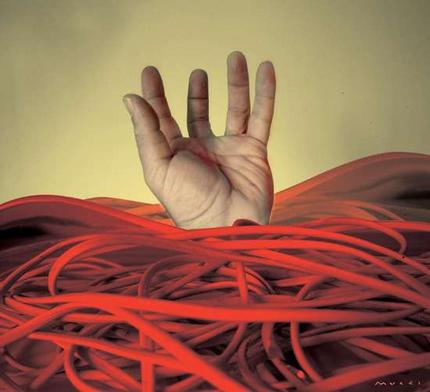 Business people and citizens drown in red tape while the bureaucrats keep making more of it. They have forms you need to order forms The idea is to reduce unnecessary regulatory and administrative processes that cost businesses time and money. The report features 28 initiatives across government that are modernizing services and making it easier for businesses to succeed, including:
• Creating a new online system for processing payments for the Ministry of Health and Long-term Care’s Assistive Devices Program — reducing wait times for payments and saving registered vendors $16.7 million and an estimated 500,000 hours over four years.
• A new, convenient online compliance check tool available to businesses with a good track record, as an alternative to full inspections under the Employment Standards Act,- saving these businesses an estimated $725,000 and 36,500 hours over two years.
• Streamlining regulations and processes with the Ministry of Transportation’s simplified testing requirements for senior commercial drivers to renew their licences — saving drivers $1.87 million and an estimated 57,000 hours over a year.
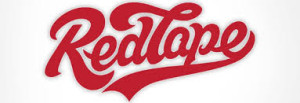 This could be the logo that could be printed on T-shirts that bureaucrats could wear – that way we would know who they are. Ontario has set a target of reducing burdens to save business $100 million by the end of 2017. With $50 million of savings so far, our province is halfway to reaching its target. This is part of our government’s broader strategy, aimed at reducing unnecessary burdens to businesses across Ontario. Since 2008, our government has eliminated more than one in six regulatory requirements – or 80,000 regulatory burdens, leading to more efficient, streamlined processes.
And if you believe all this – there is a nice parcel of land in Florida I would love to sell you.
What I want to know is – how many civil servants did the counting of all those hours that were saved?

|
|











































































 Some of the comments on social media:
Some of the comments on social media: There are thousands of comments like this being made on social media. What we haven’t seen or heard are public statements from the office of the Mayor expressing concern over what can only be described as vile.
There are thousands of comments like this being made on social media. What we haven’t seen or heard are public statements from the office of the Mayor expressing concern over what can only be described as vile.








 As we move closer towards a critical election in just over 100 days this might be a good time to reflect on the Canada you want and which government you believe will get us all there.
As we move closer towards a critical election in just over 100 days this might be a good time to reflect on the Canada you want and which government you believe will get us all there.






